So long as one can keep killing them at the same or faster rate, victory is ultimately inevitable.
- 2
- 1
I've found a good use for them, I think, and am glad I've boosted the range on those V2s to be able to strike enemy air bases in depth. The attempts to do so with STRAT far less damage and got two of my three Strat groups cut up quite badly.V1/2s coordinated with INTs worked out to be great! The skies are all hammer and sickle!
I'll keep topping them up as necessary.In fact, I think best would be to make sure the production lines for the V1/2s never stopthey seem to be very useful. I never used them before and now I regret it.
No, in fact they have been taking a bit of a hammering and the Allies air forces are only temporarily set back - and they will probably be able to send more forward if their bases have the space to accommodate them (which my V weapons are keeping suppressed, at least).Is it possible to turn the TAC bombing a notch or two? Since we have air supremacy we should use it well to pound them to smithereens which would translate to success on the ground
I only have the transports to drop one at a time, unfortunately.I don't know how expensive that would be, but maybe paradrops should concentrate more divisions at one province in order to make it less taxing for each division
Not out of INT range, but they are separately tasked, trying to keep the invasion fleet safe. I think, in hindsight, I didn't produce enough extra INT and M/R wings: it's getting hard to sustain high intensity air ops and cover multiple tasks.A bit of a bloody nose for the air force, is this out of our INT range? Maybe need some MRs here
You will soon see more - though I cannot promise there won' be more!Biggest cliffhanger of the war so far
One can hope so, but they have the numbers on their side with so many Allied countries to trickle reinforcements to the front. But we shall keep thrashing away as best we can (with AI Army commanders, at least).So long as one can keep killing them at the same or faster rate, victory is ultimately inevitable.
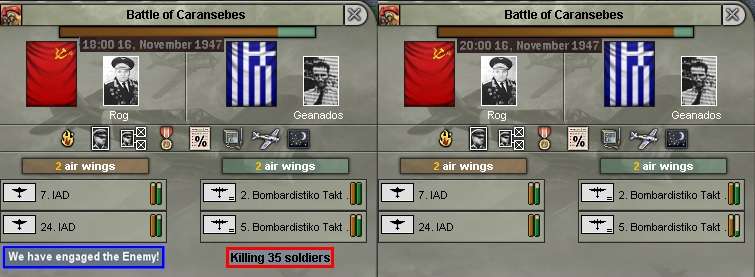

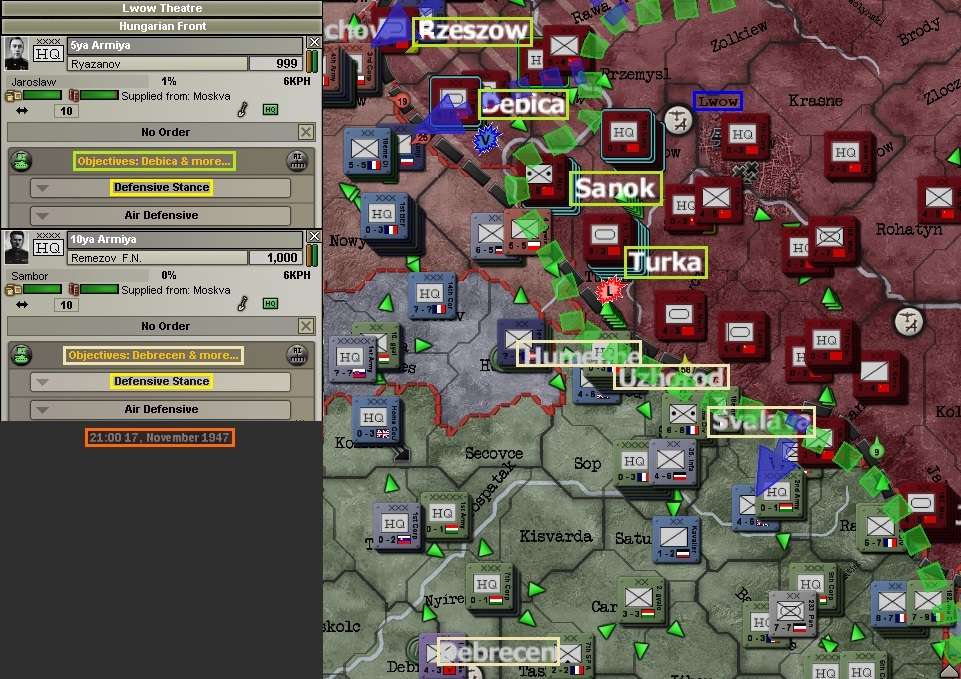

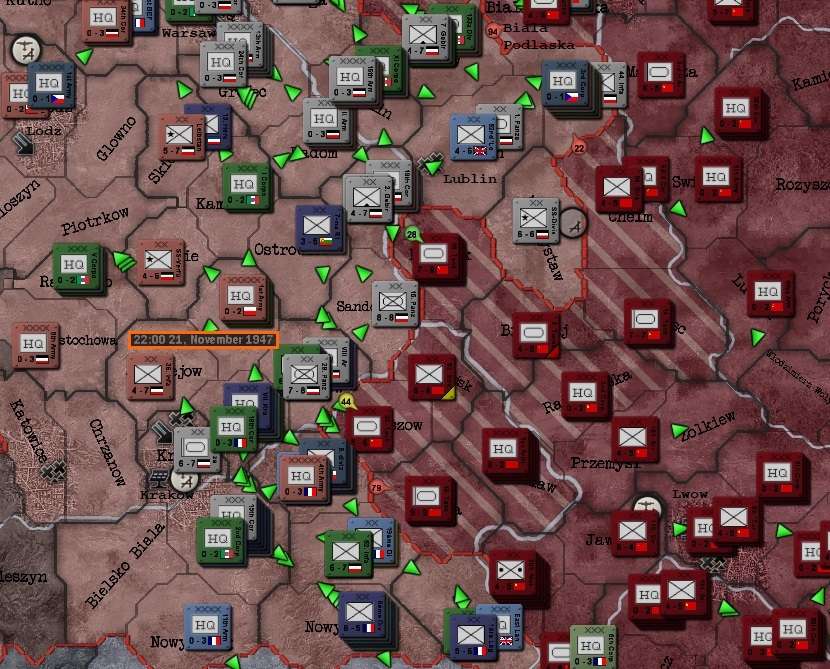
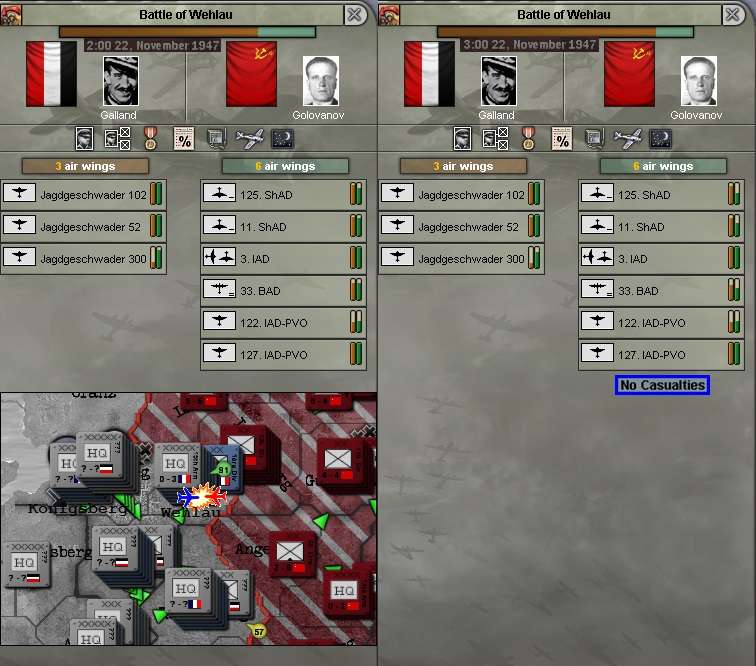

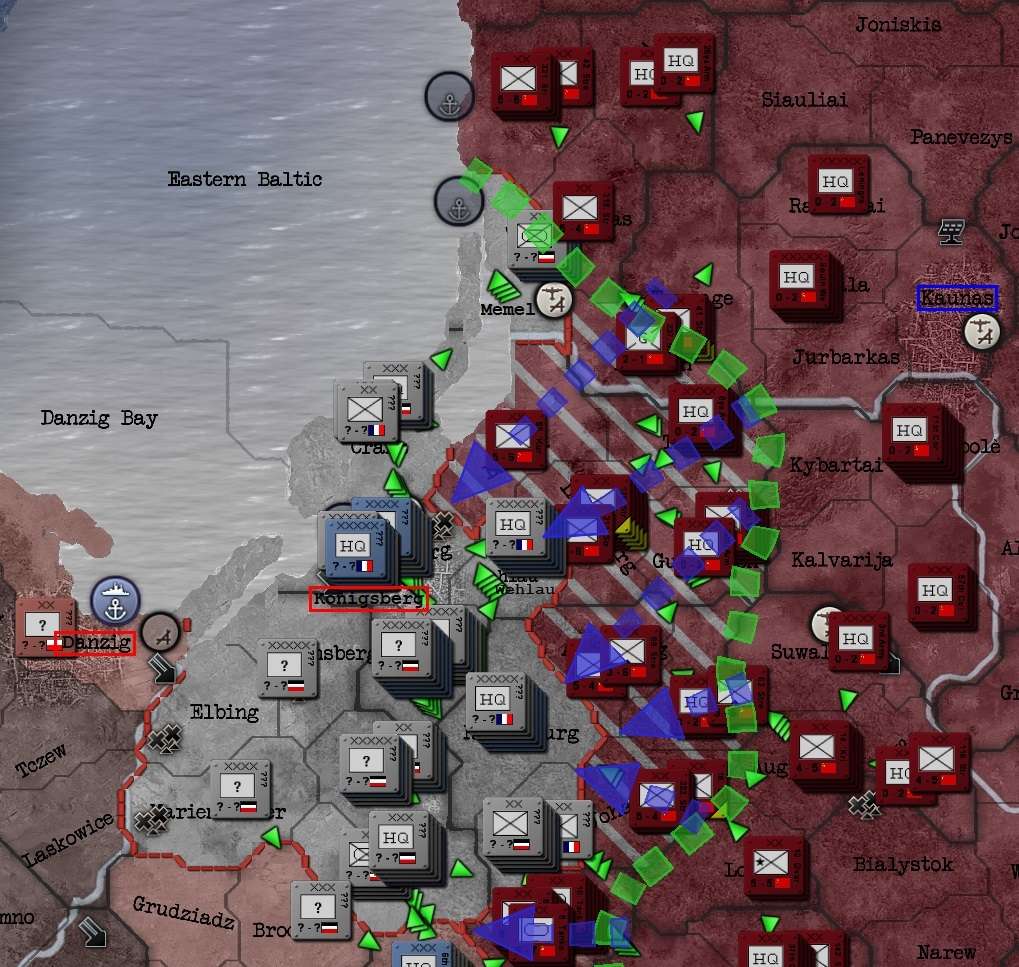
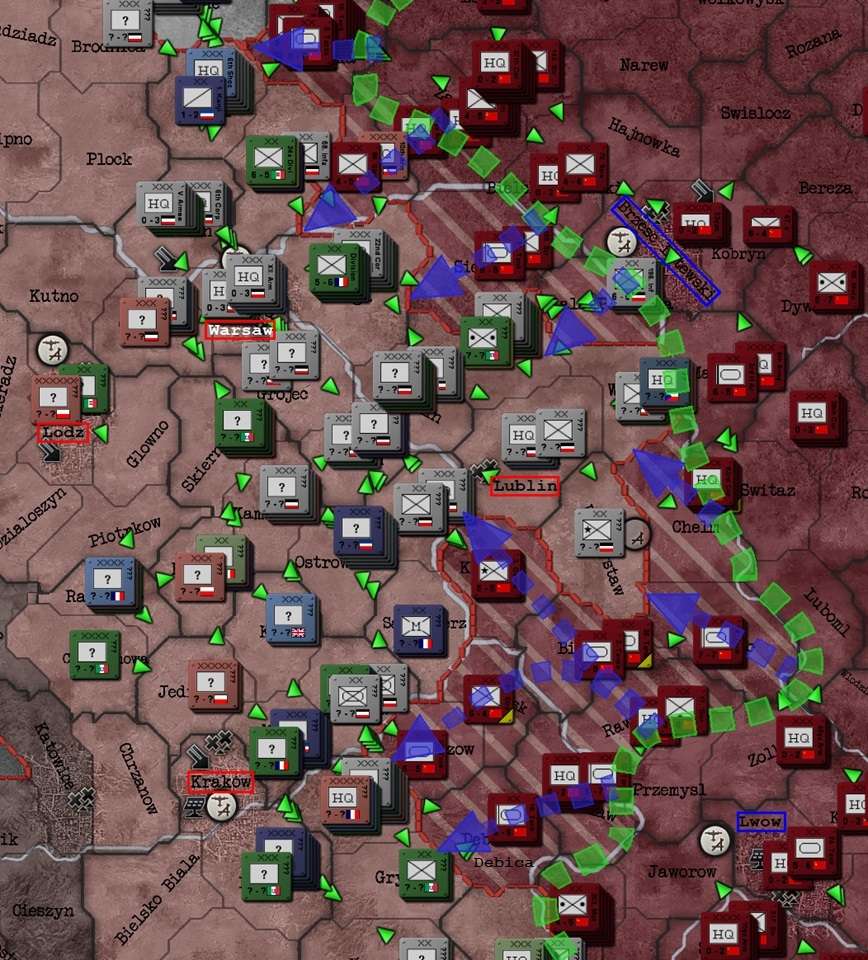
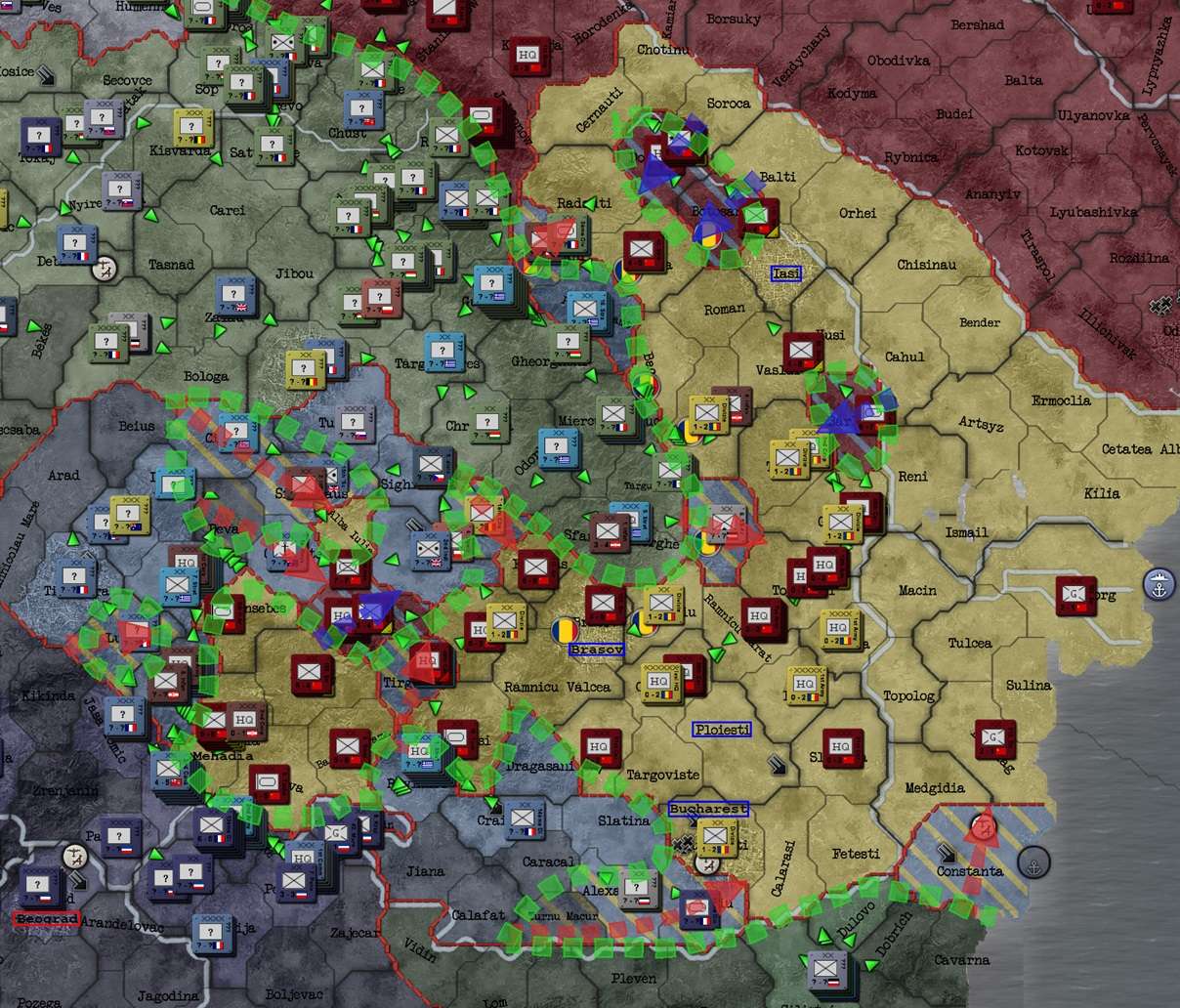
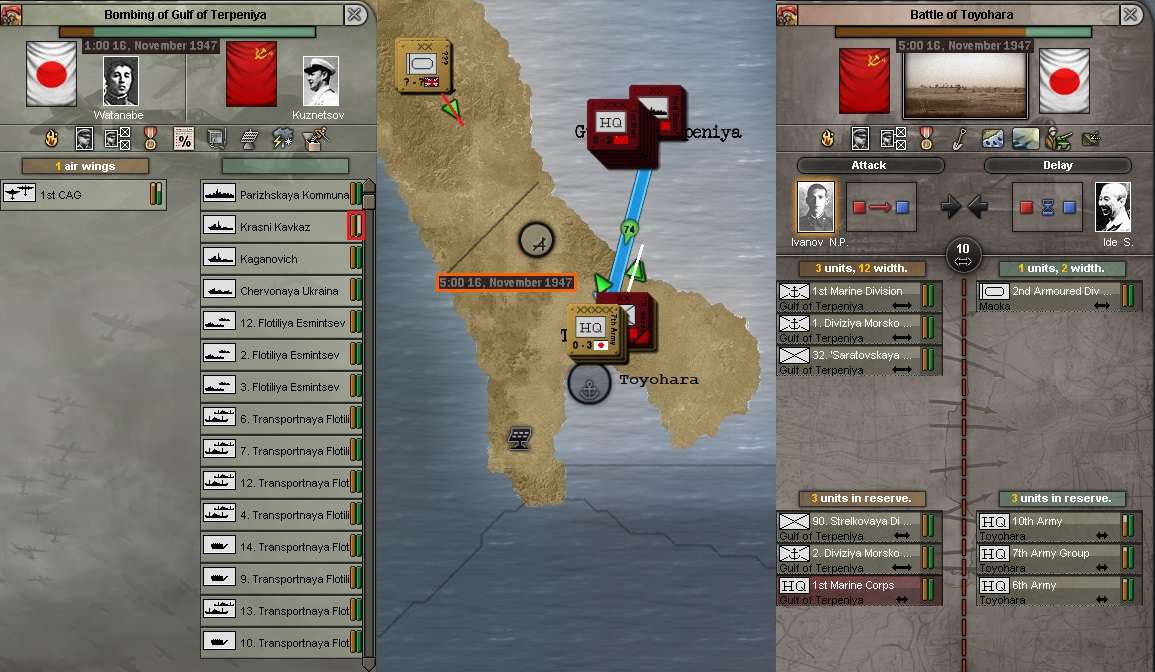
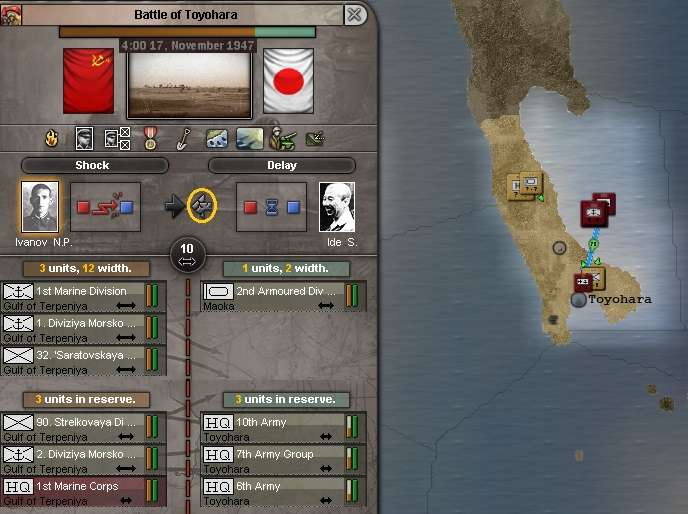
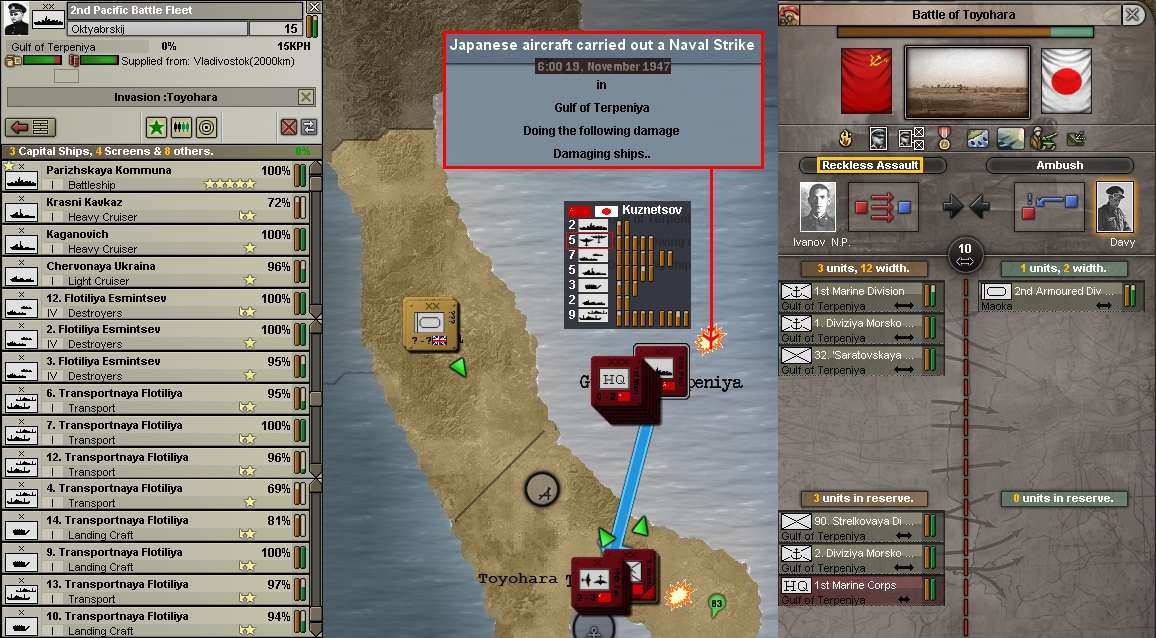
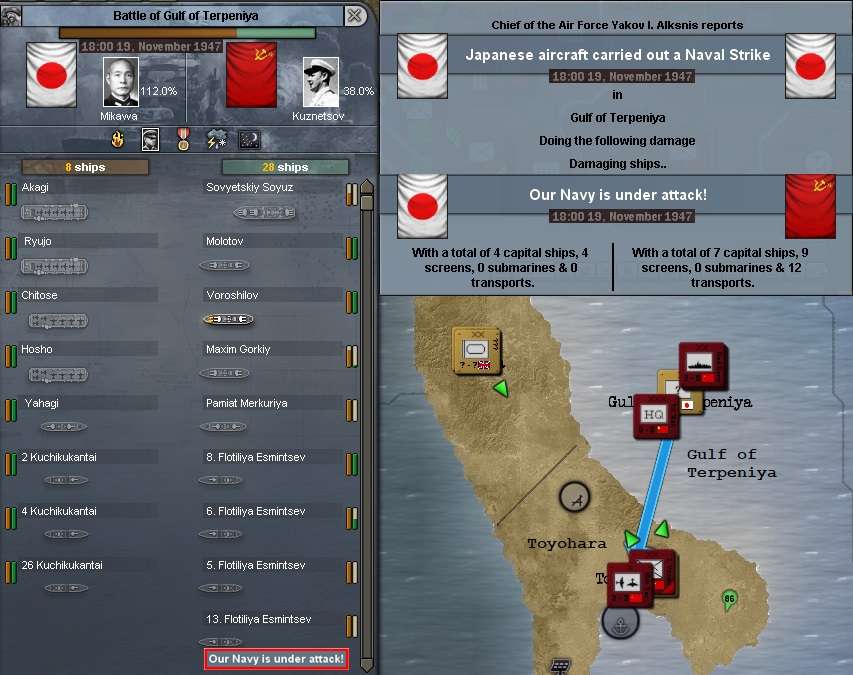
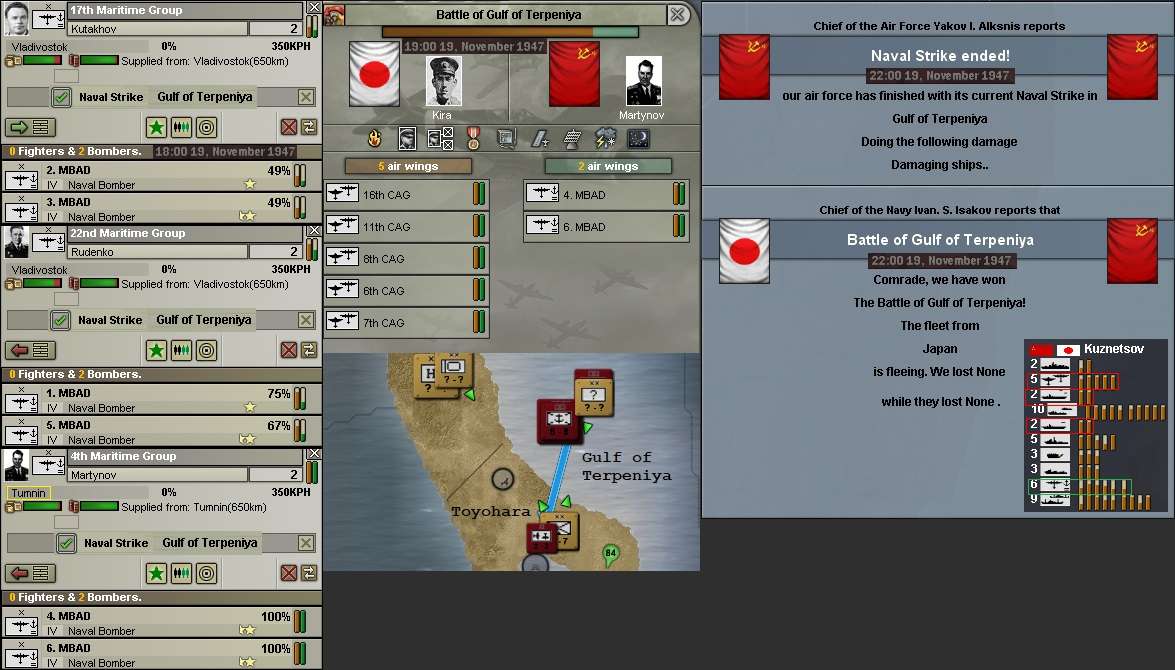
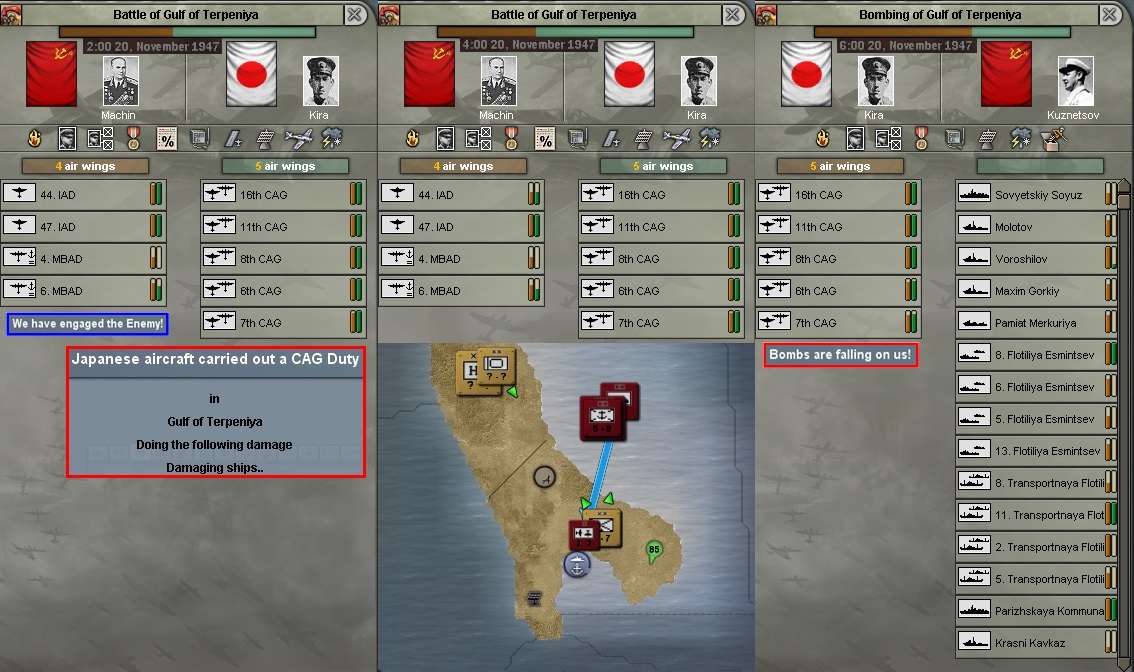
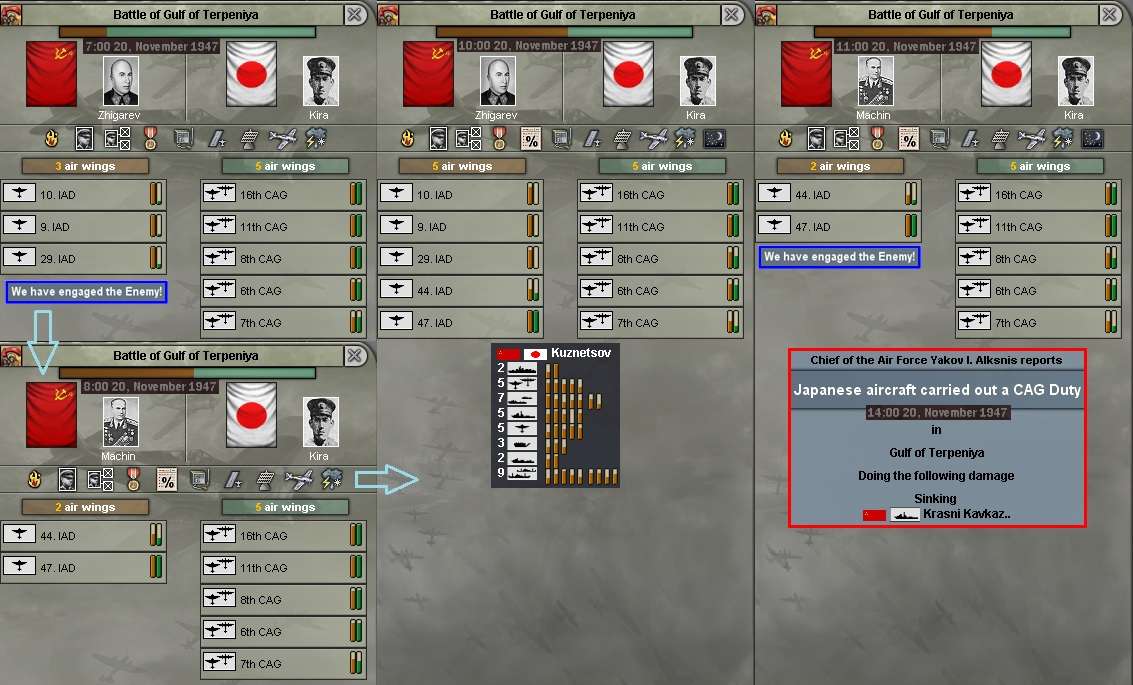
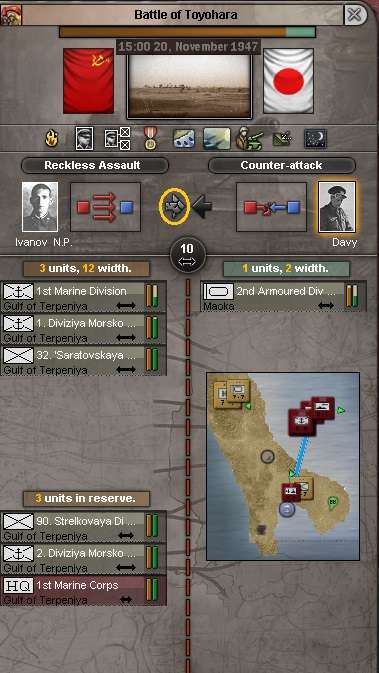
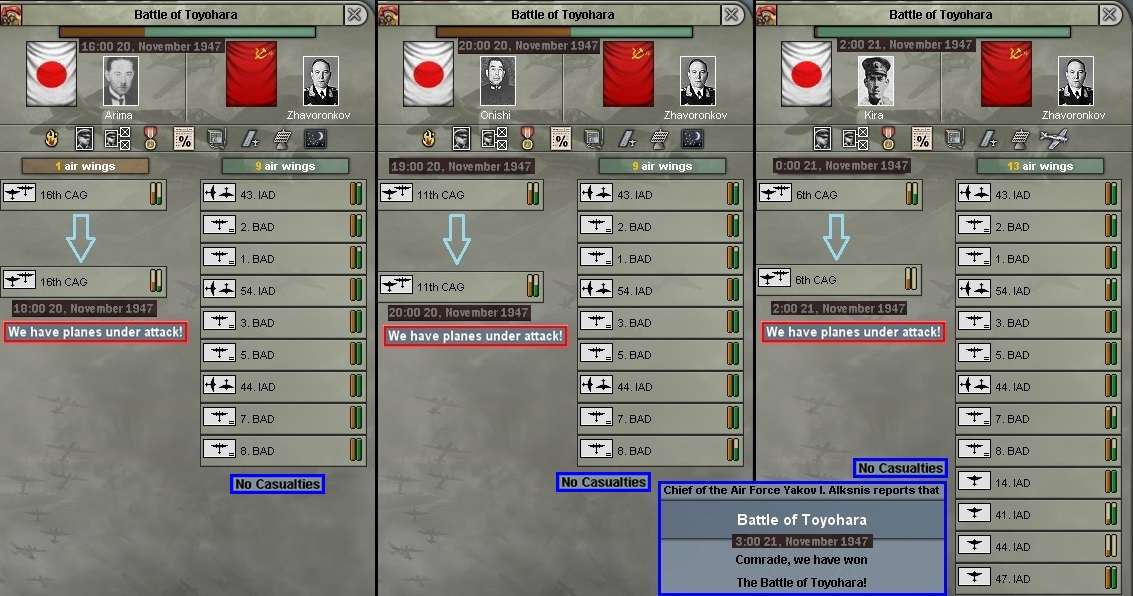
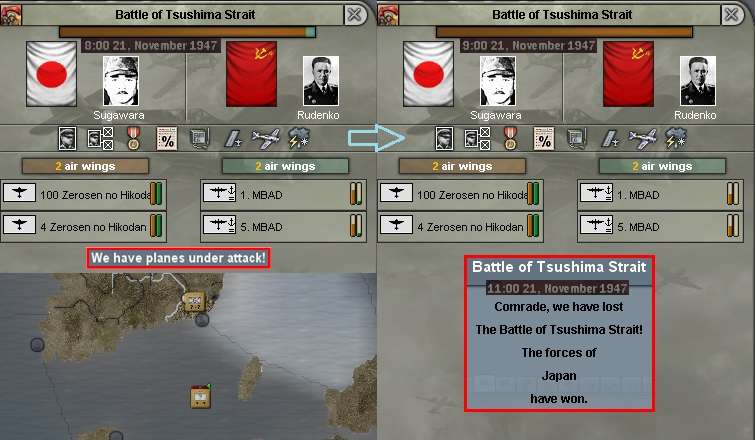

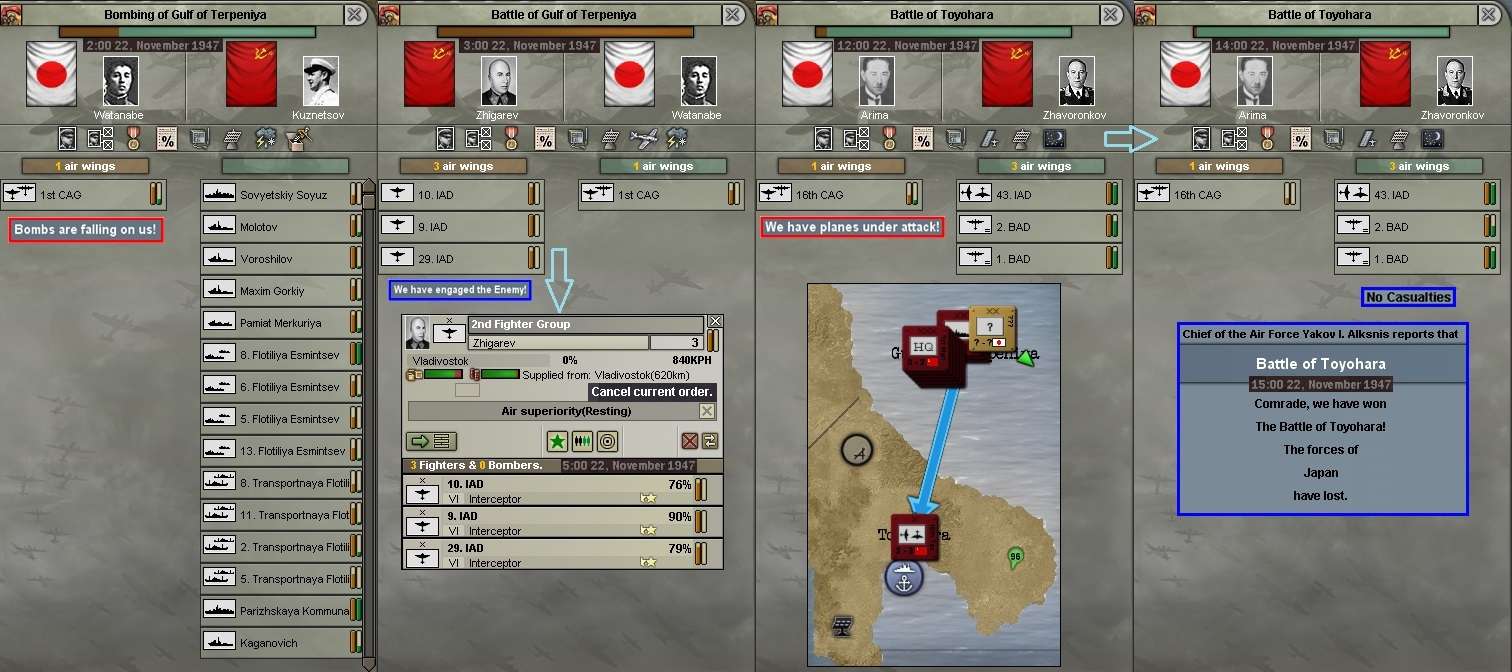
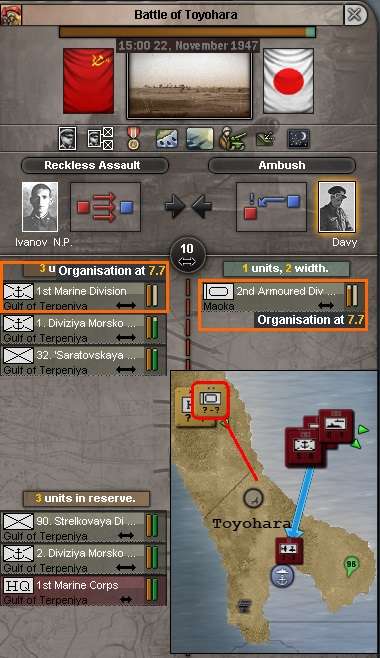
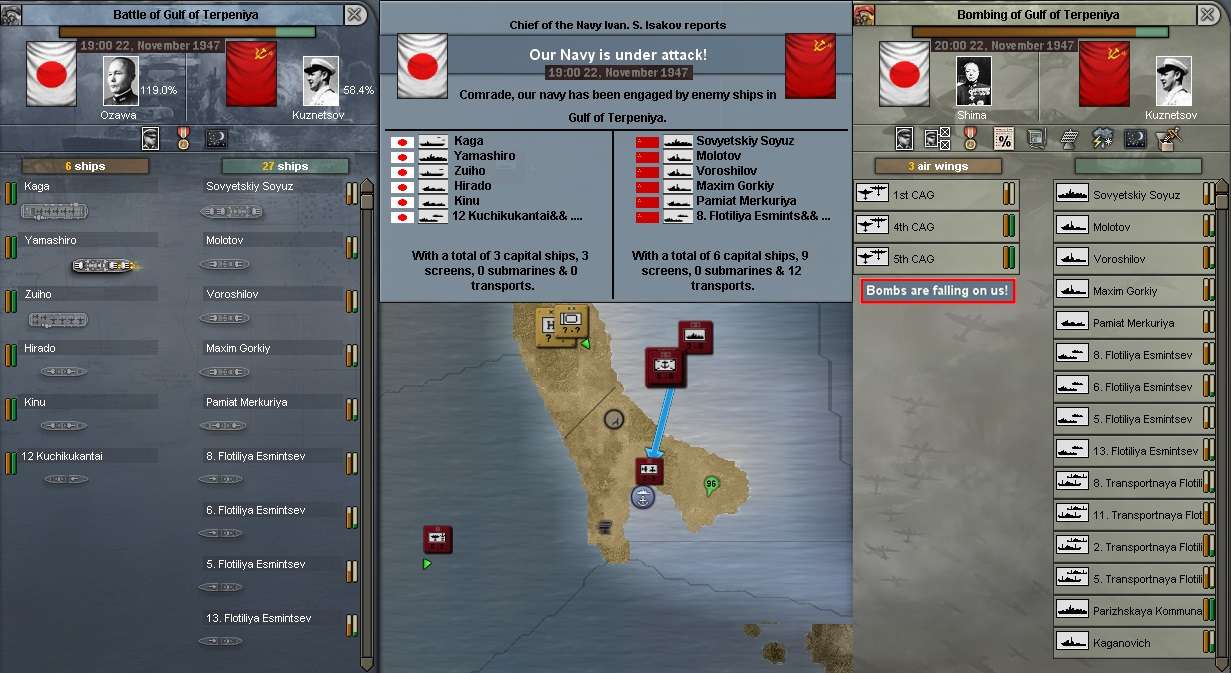
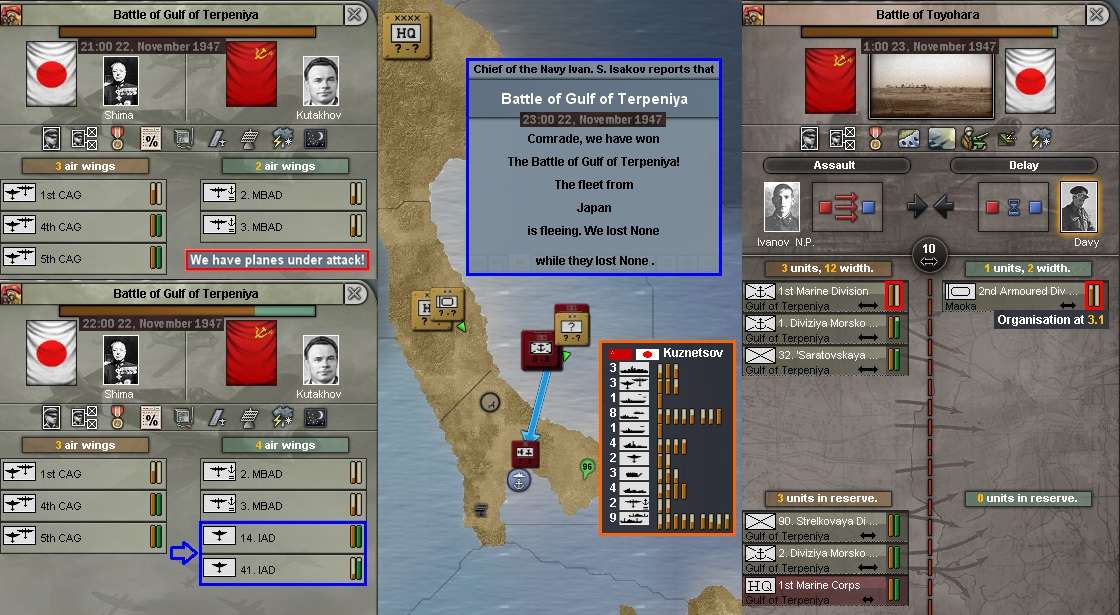
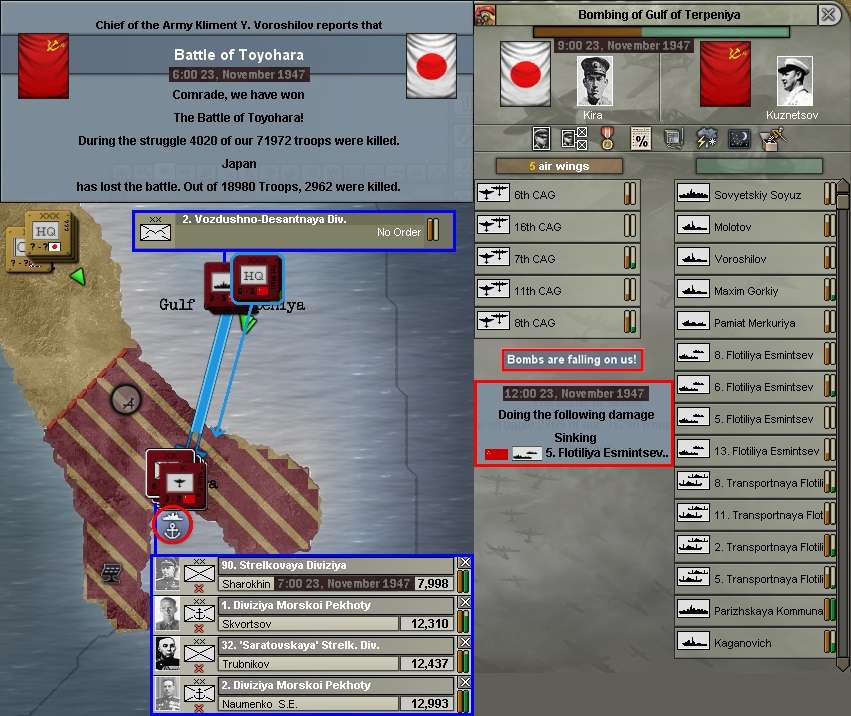
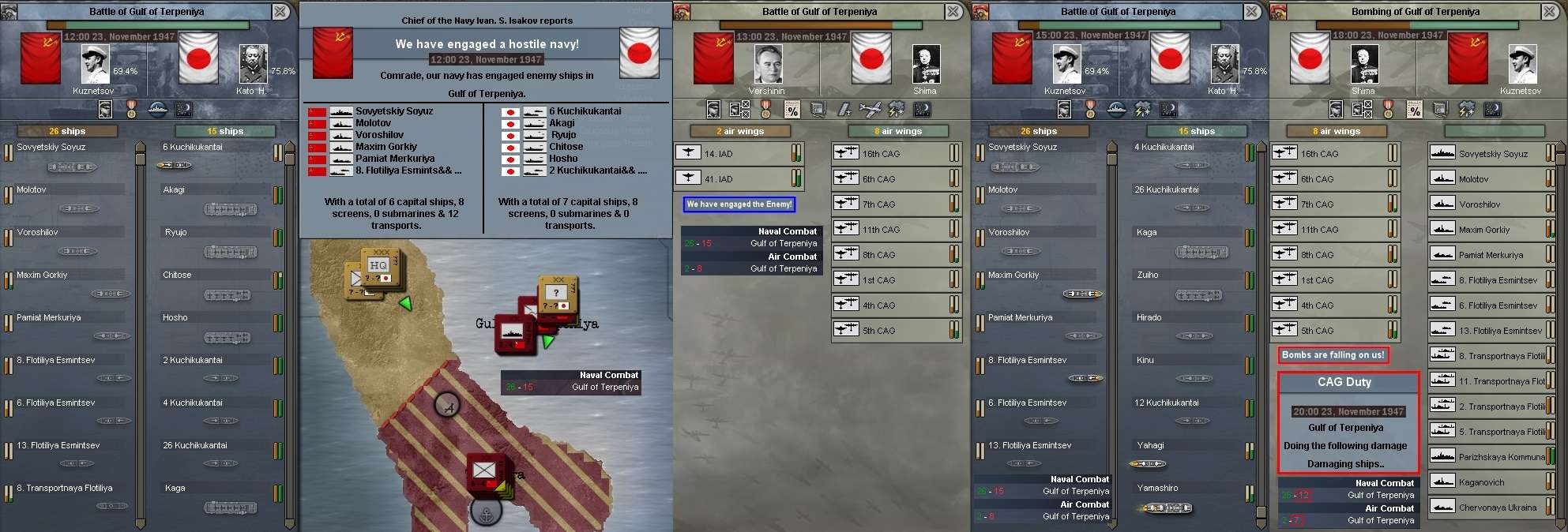
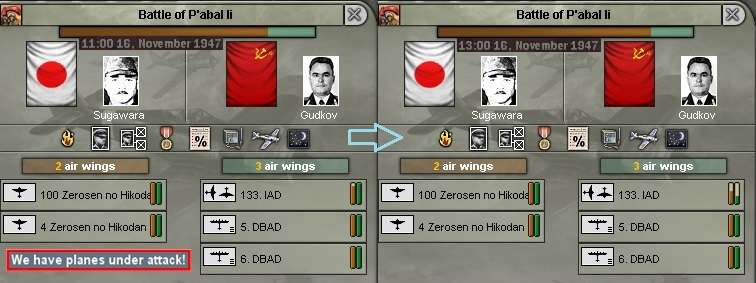
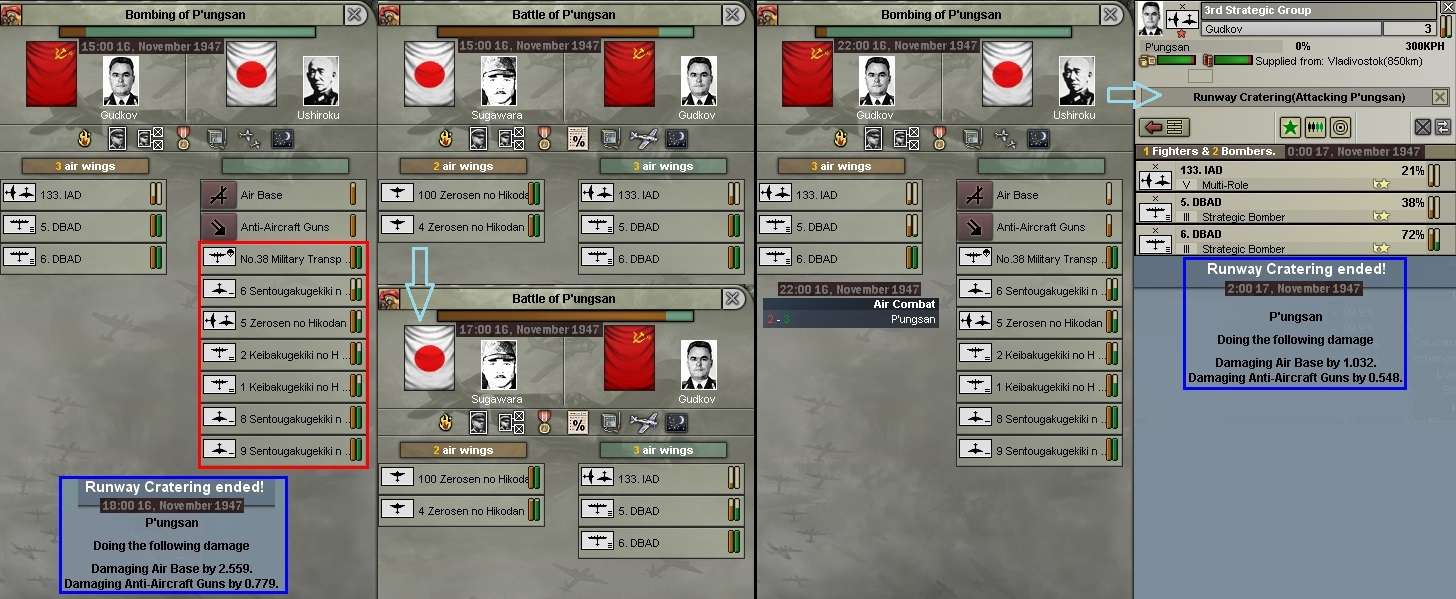

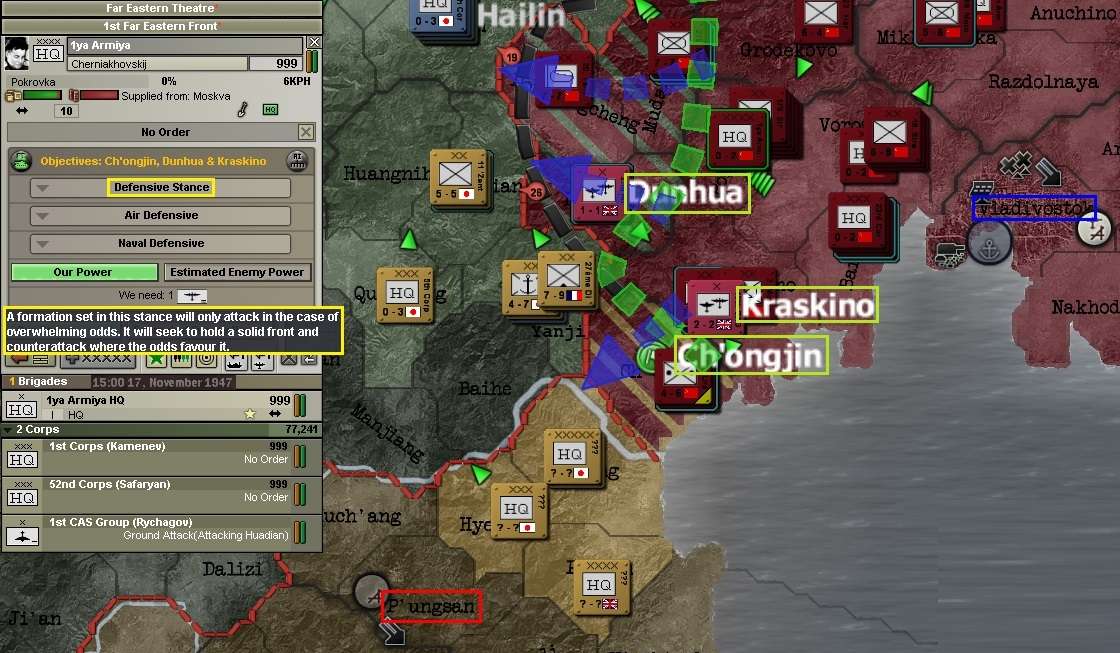
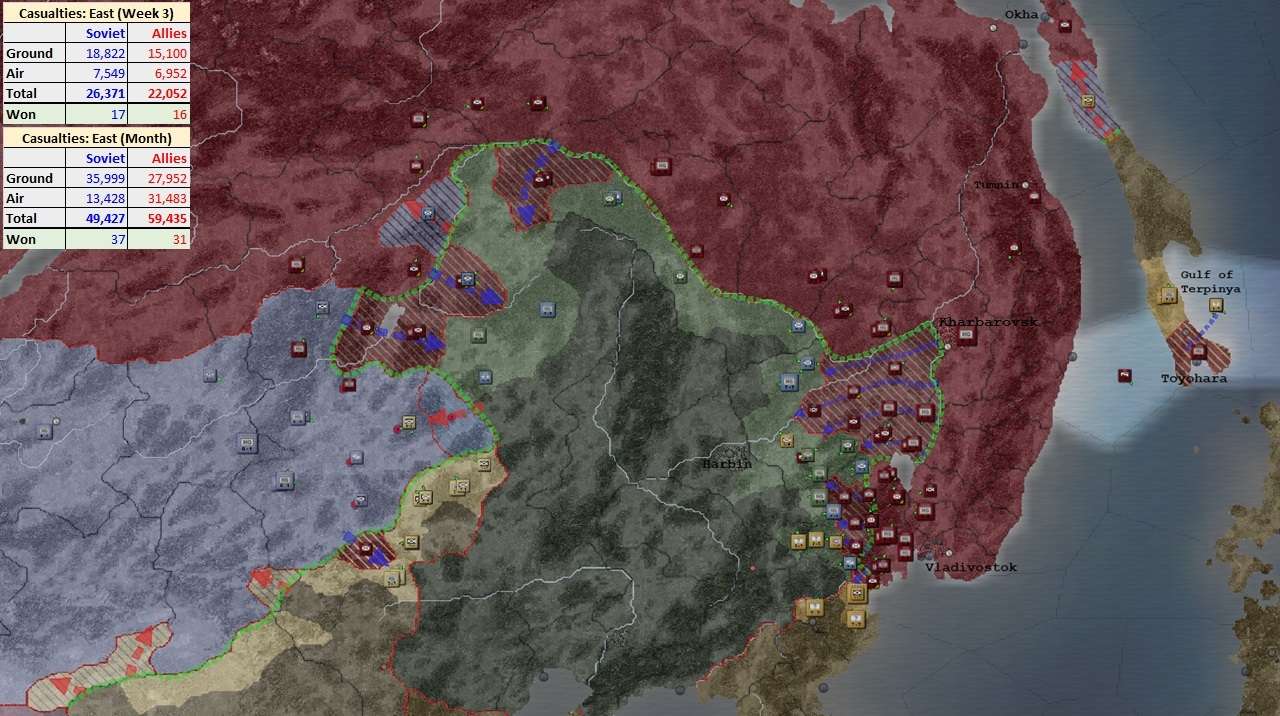
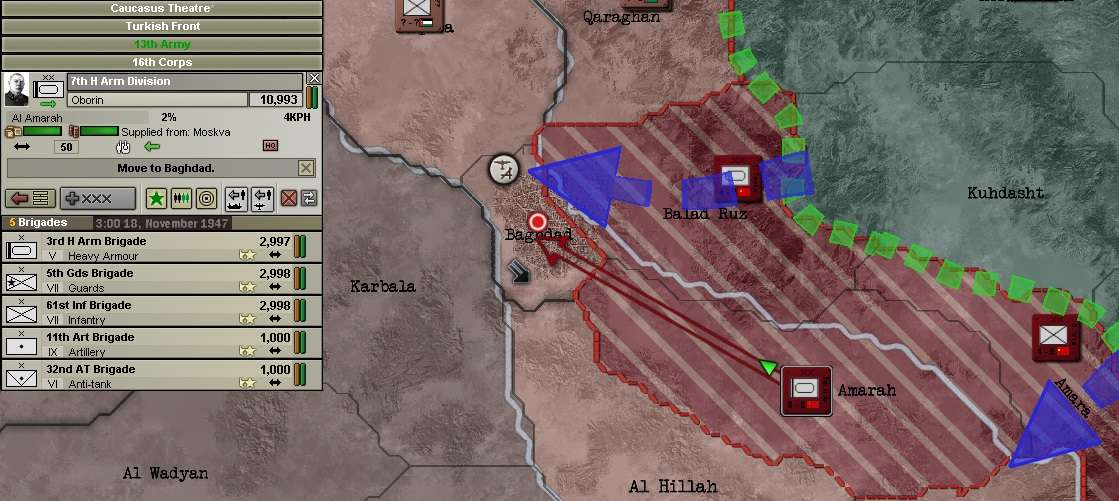
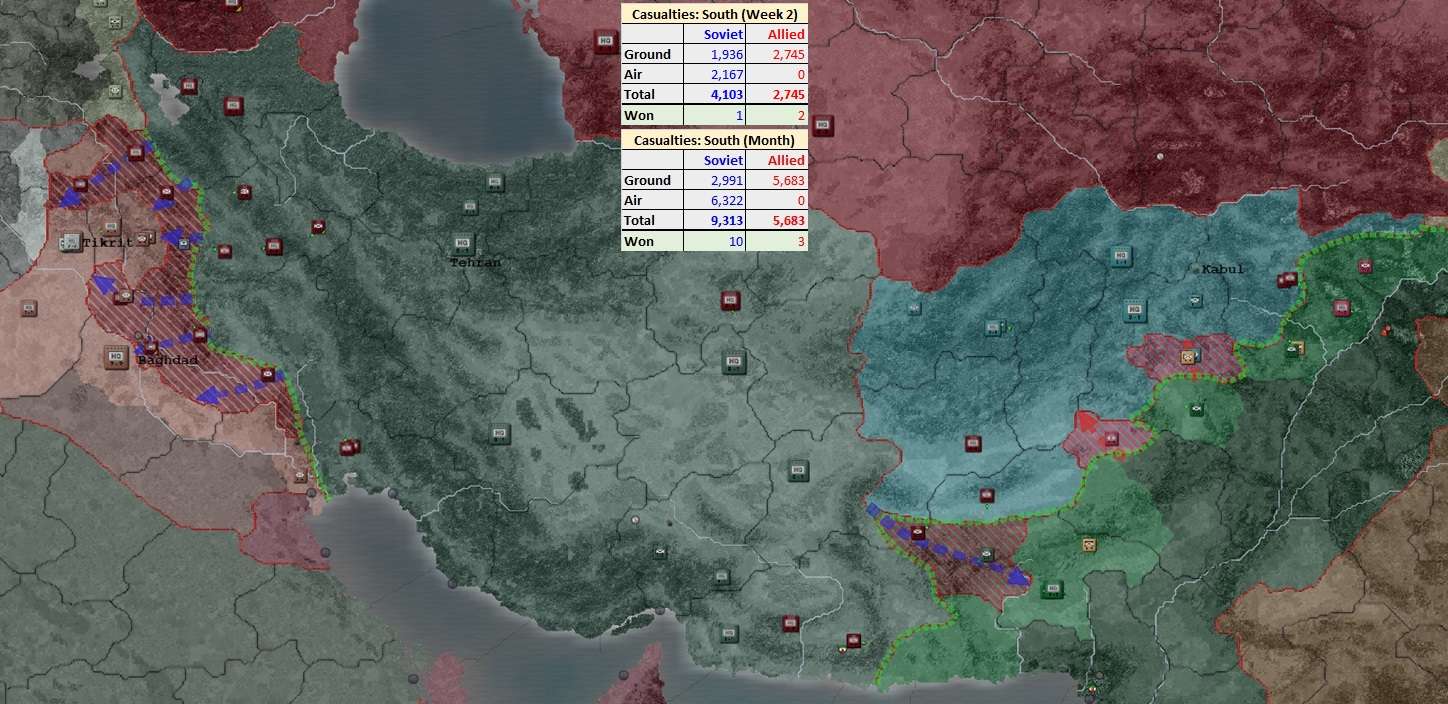
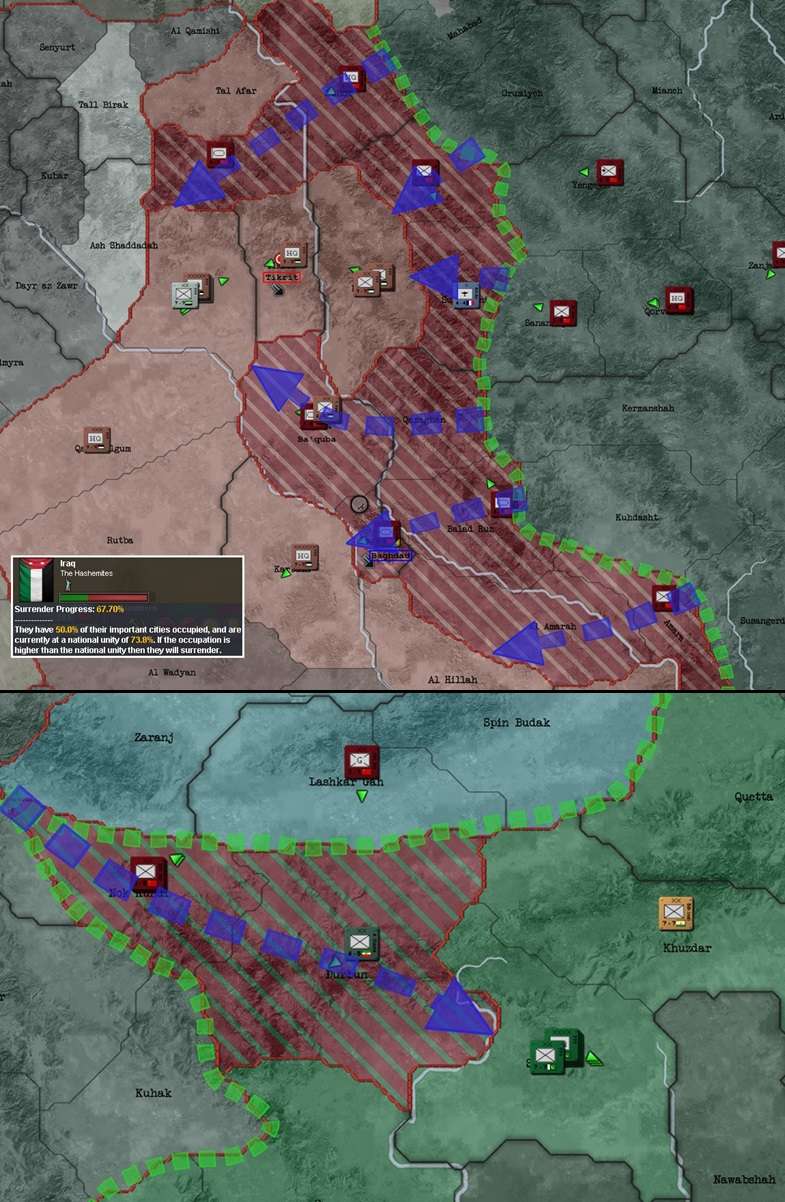
I'm not!A bit disappointed by the lack of allied air power.
It's in the balance, definitely. The failure to punch through in northern Poland was a big blow.The outlook in Europe is starting to not look as good as it did the previous episode, we're barely hanging on with the aid of air supremacy and if that was lost we might be toast.
And the story still has a bit to play out, as the naval and CAG battle continues.The saga of Toyohara was a great one! Our NAVs showed to be a great and much cheaper asset than building a surface fleet from scratch. Their CAGs were a pest though.
Maybe - it will soon be revealedI think you have some plans in mind to turn this whole war around, and I'm curious to see what they are and how will they go
It was a close fight for Toyohara, but Stalin became determined - obsessed even to see it through.Nailbiting stuff out East. The progress in Iraq is interesting - onto Egypt?
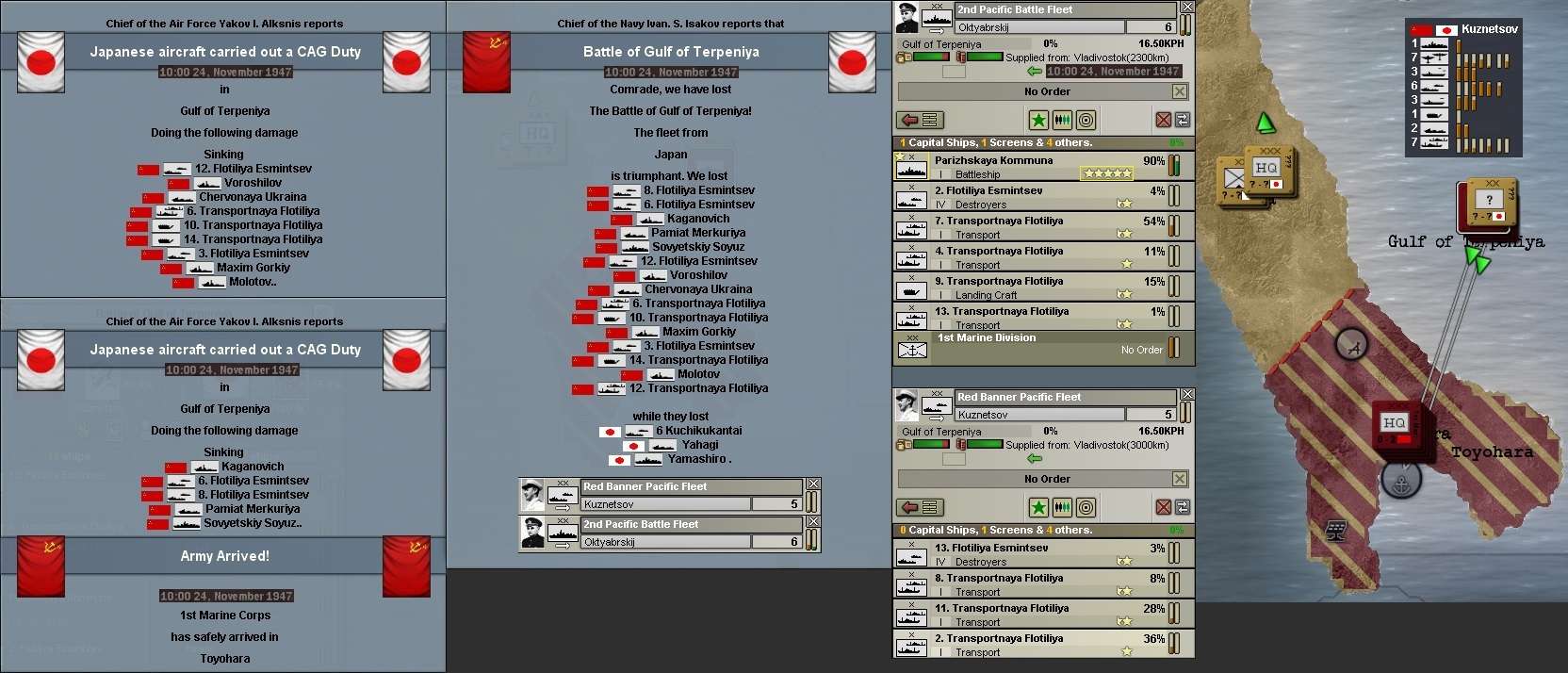
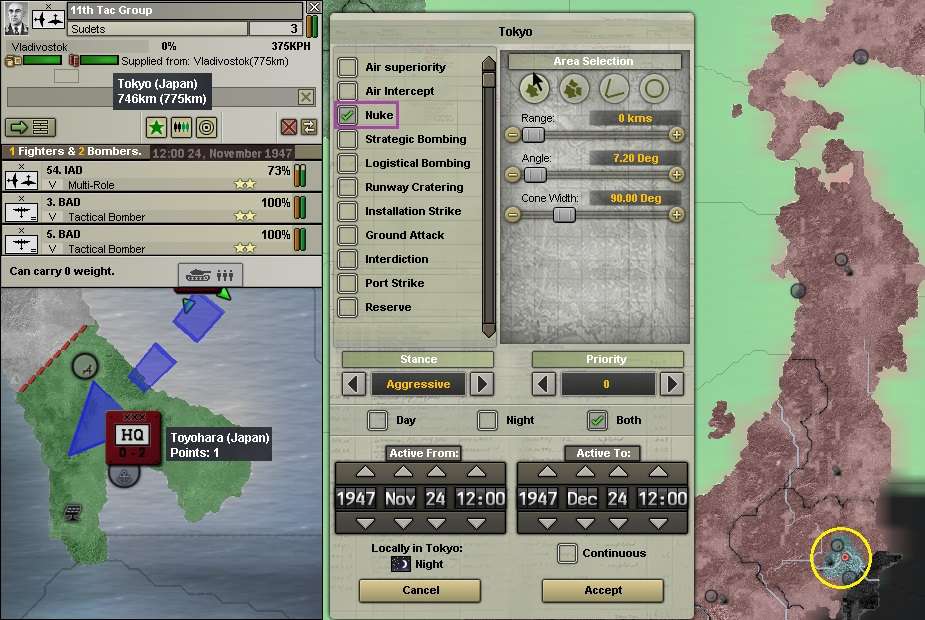
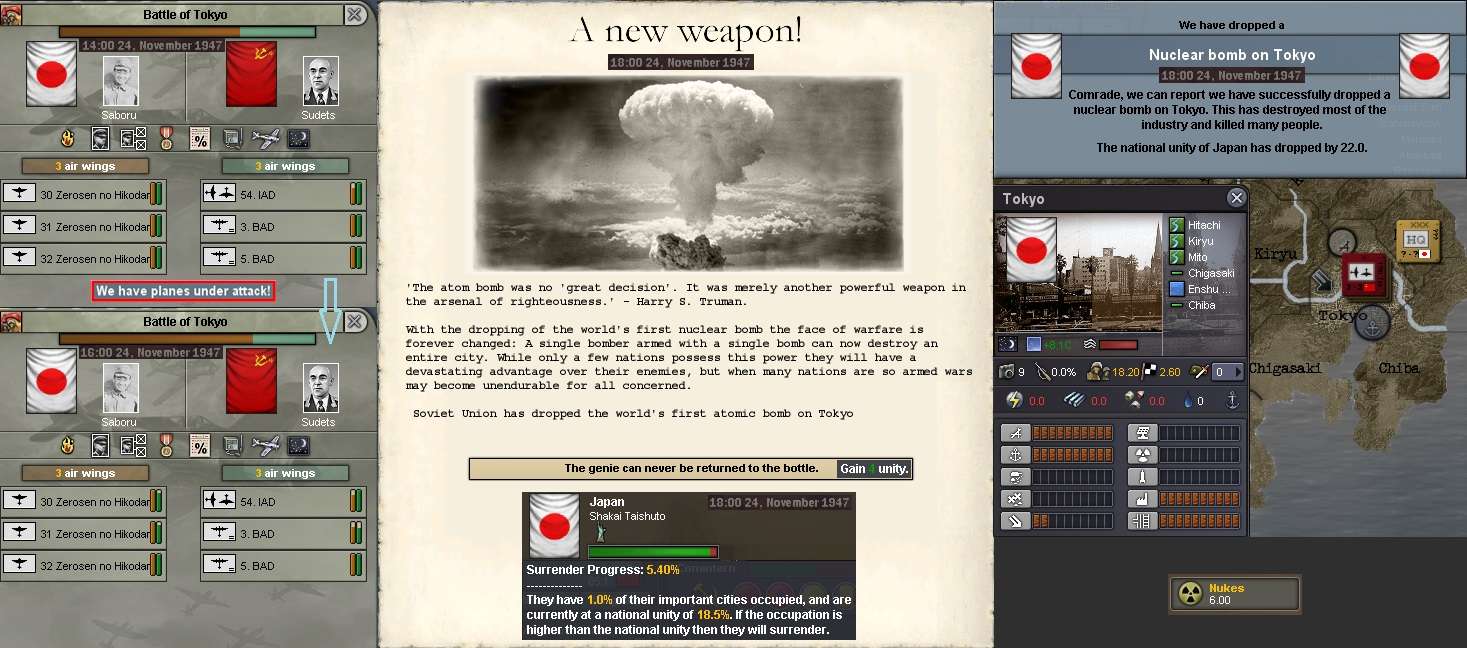
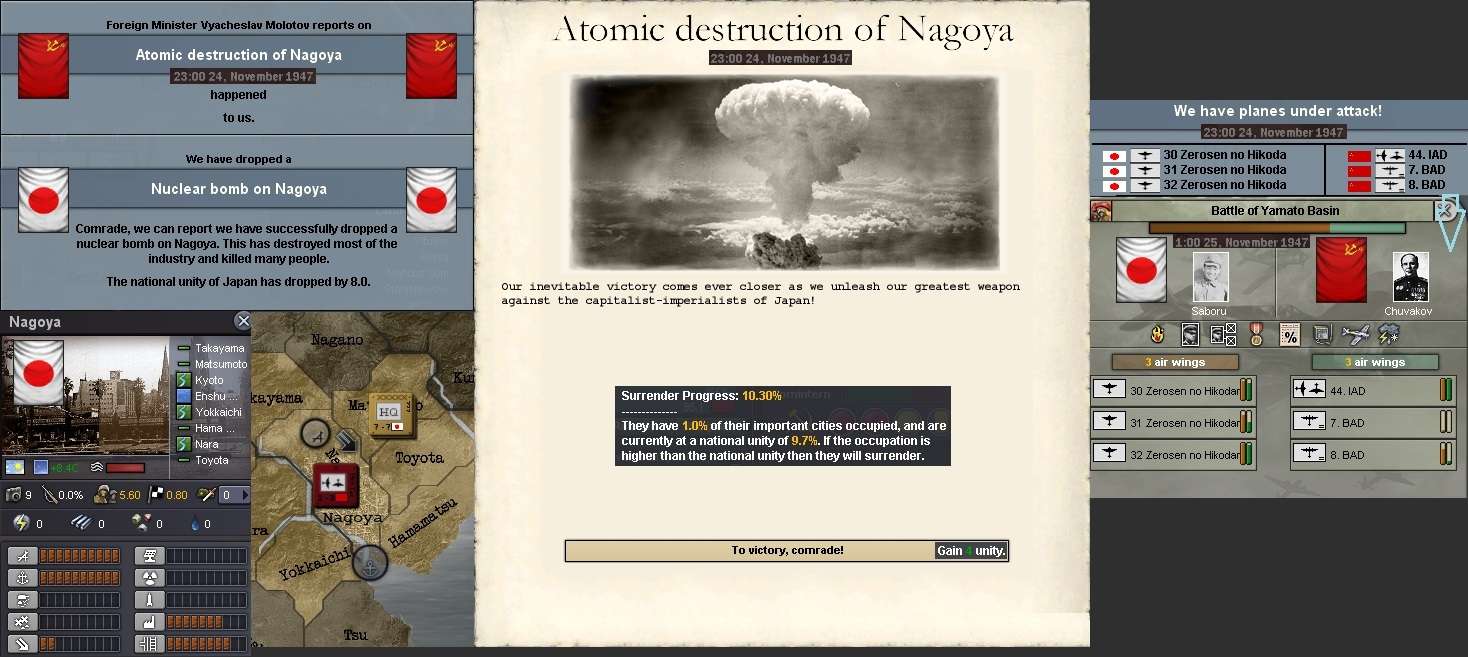
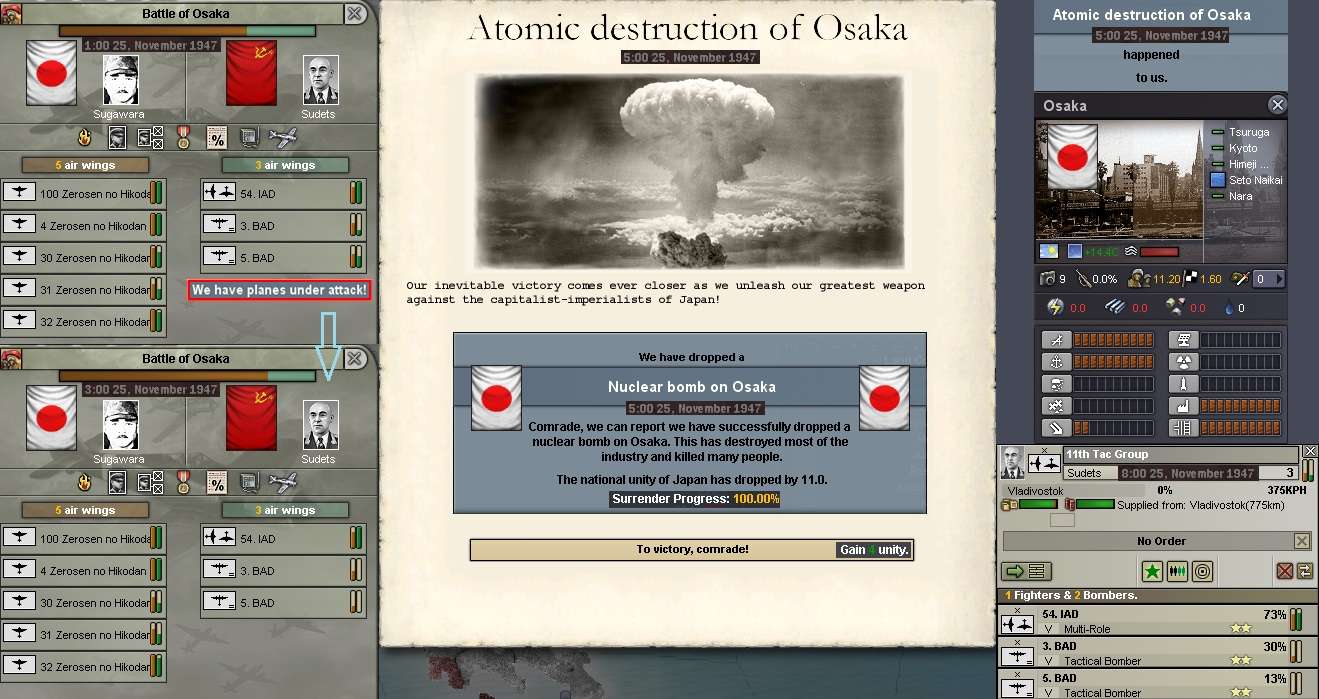

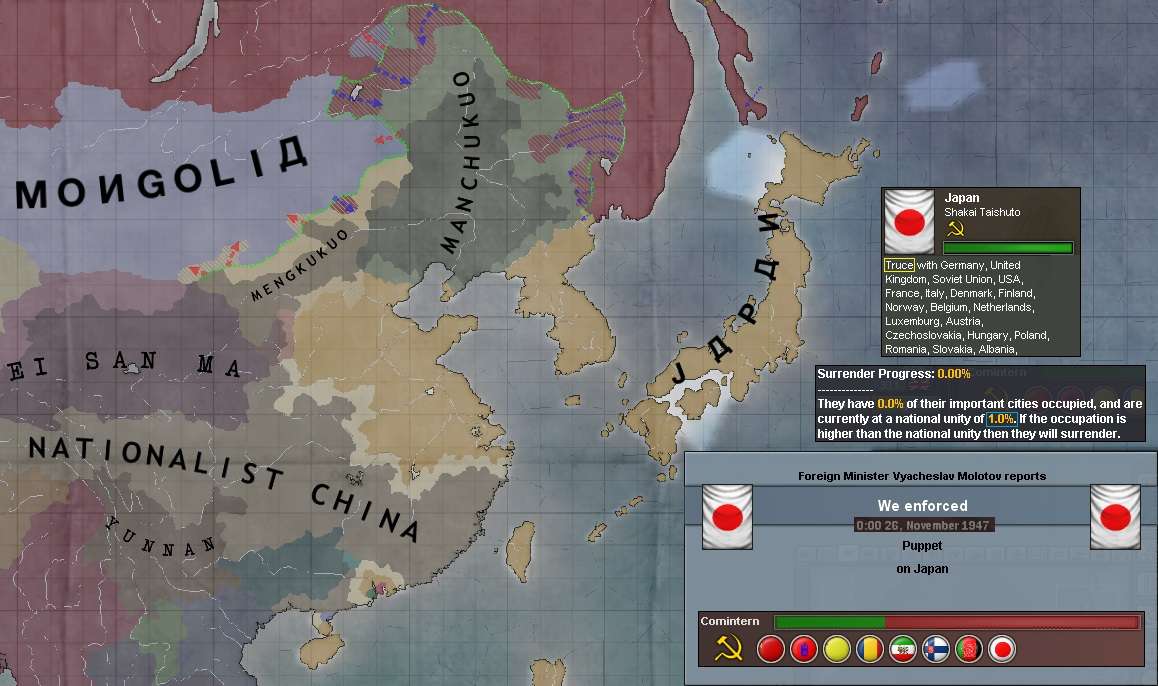
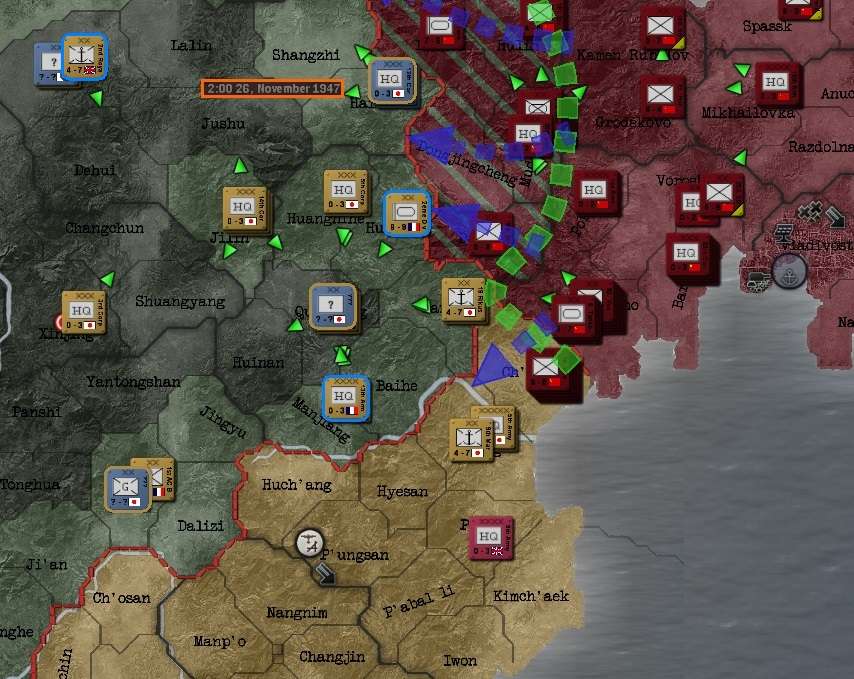
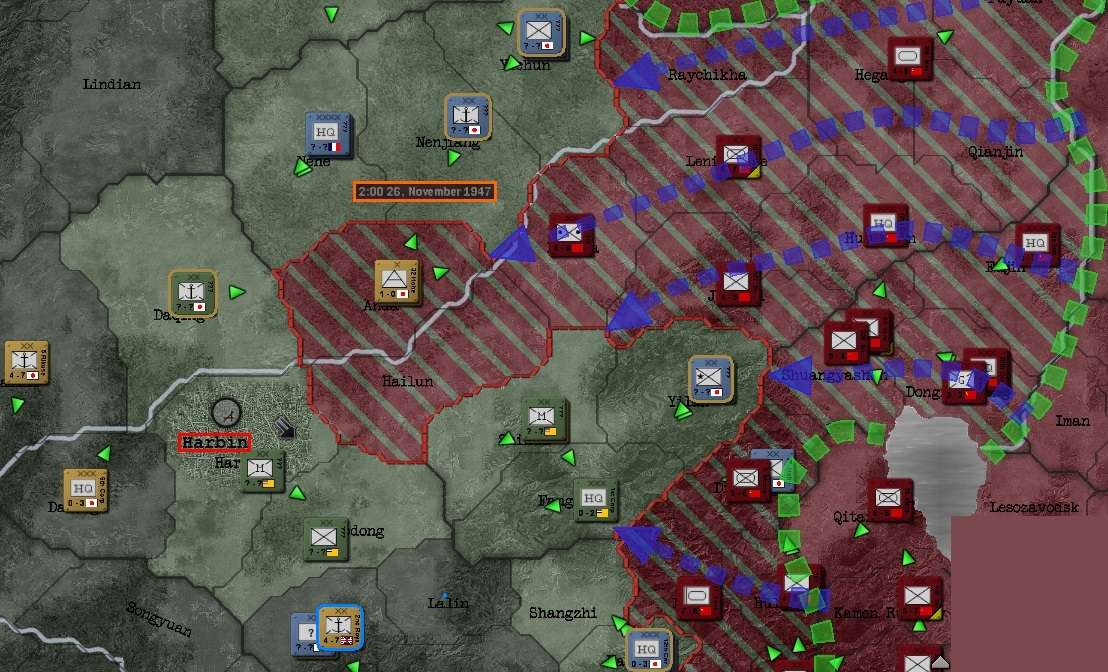
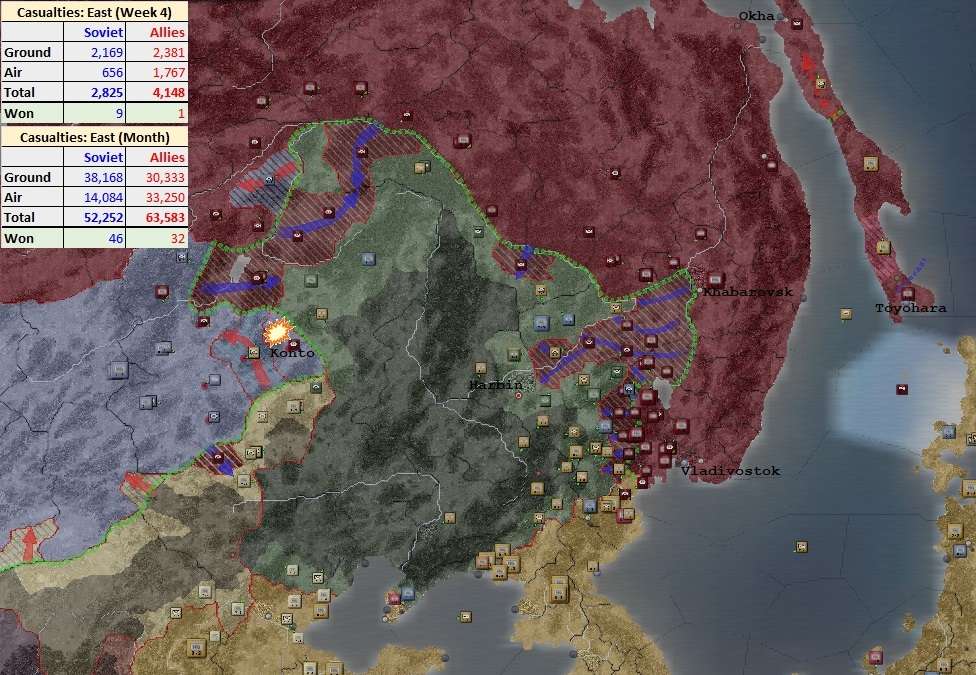
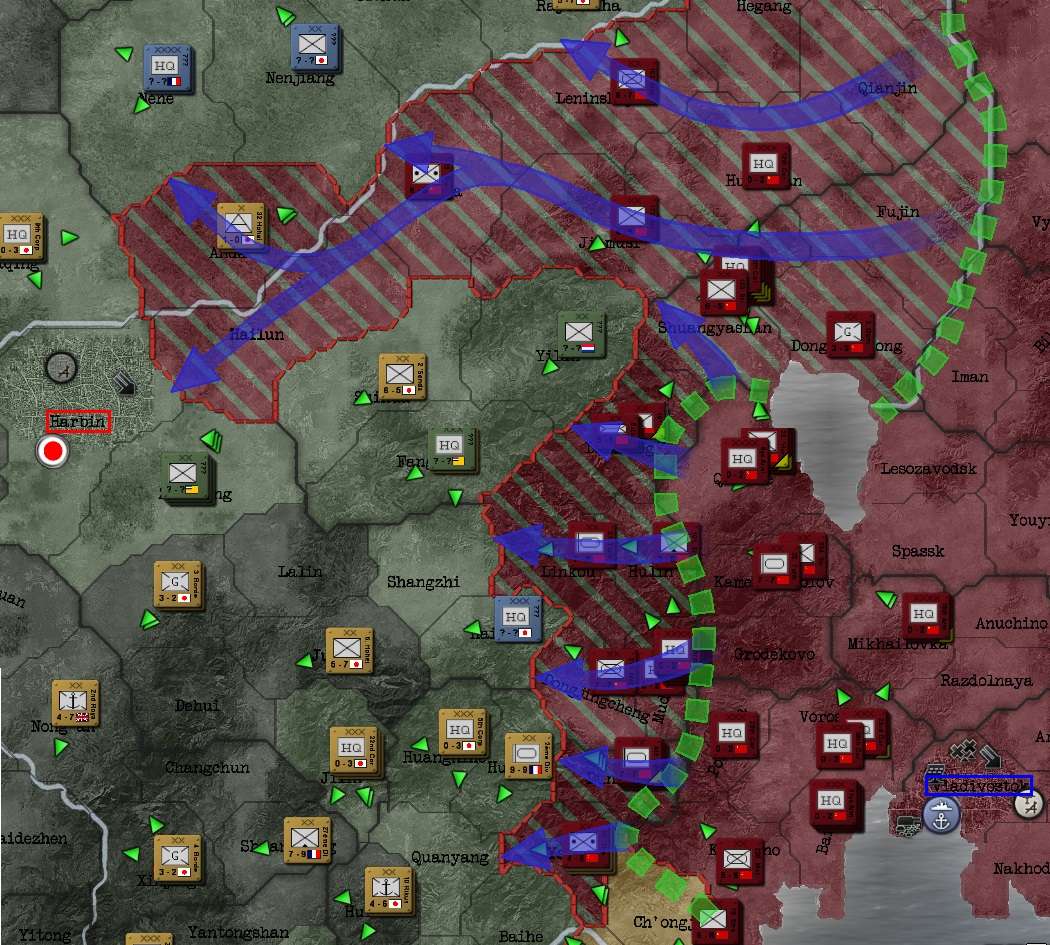


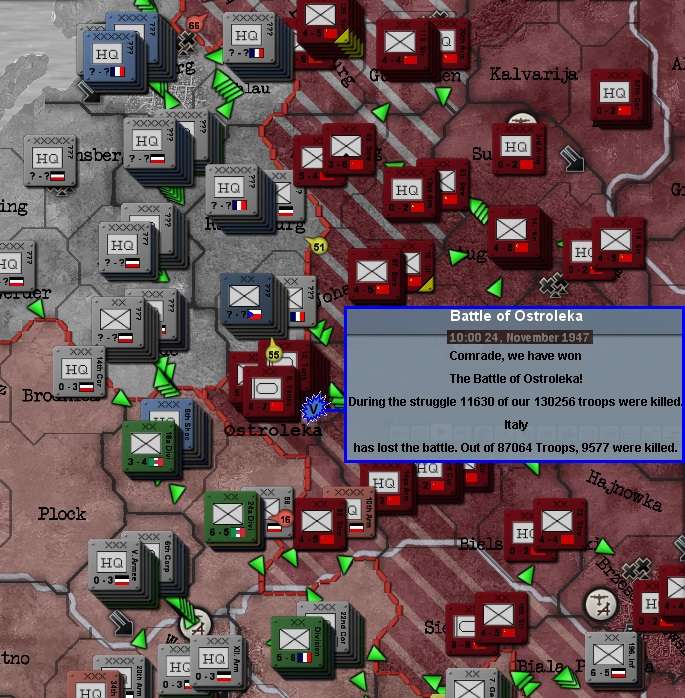
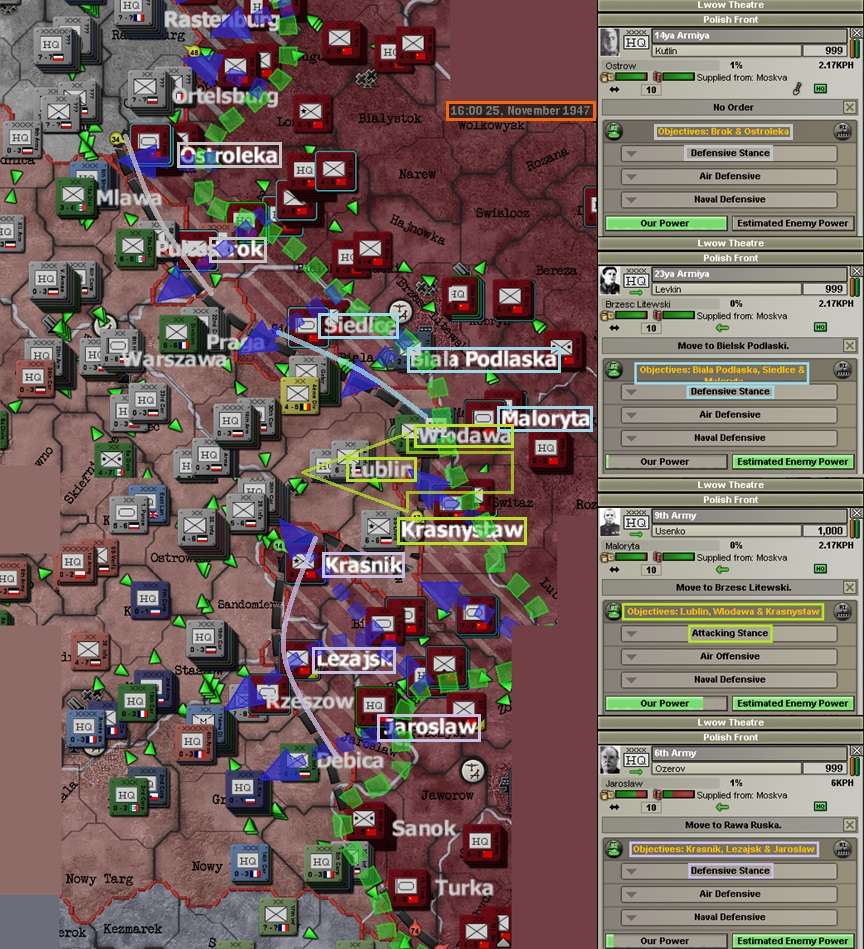
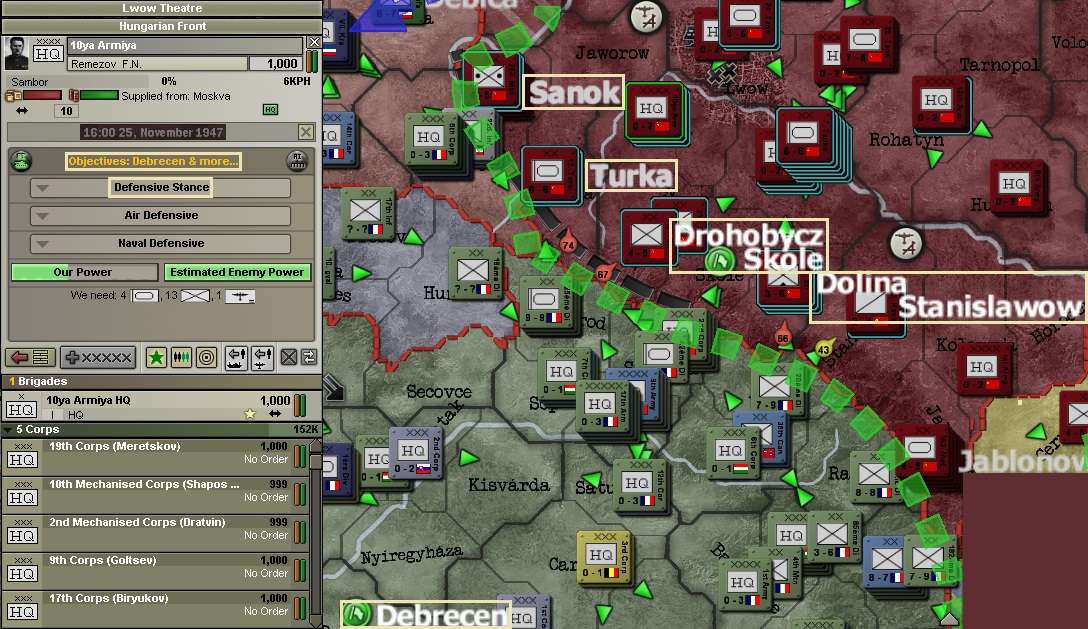
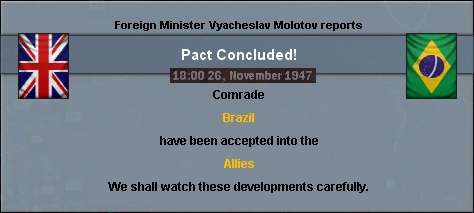

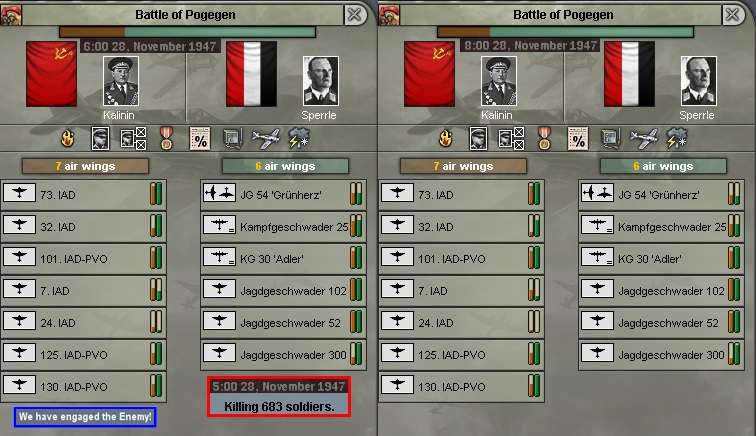

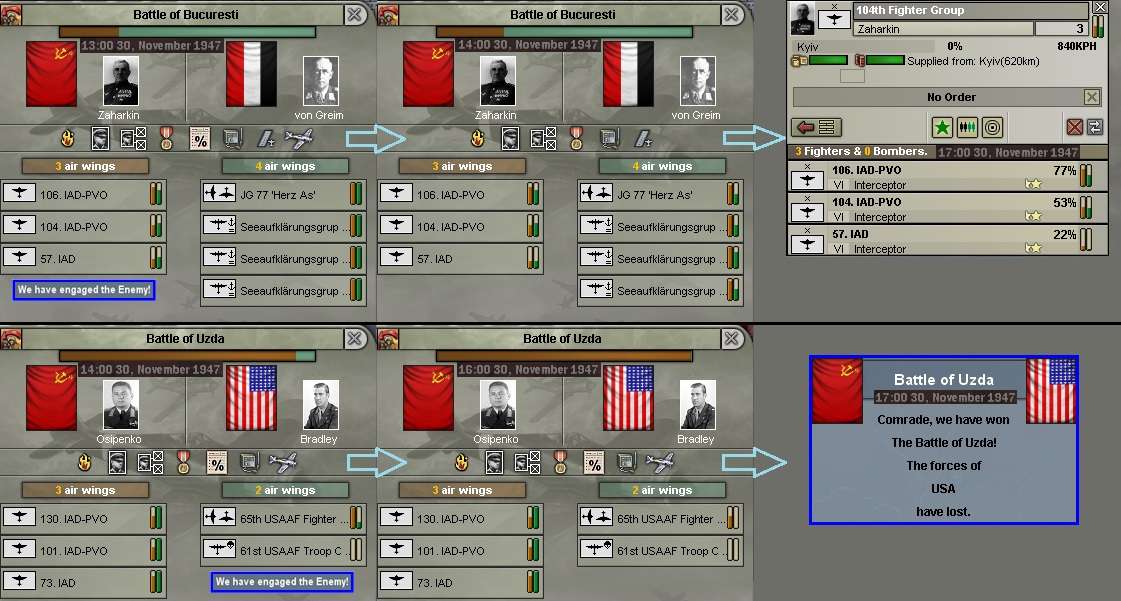

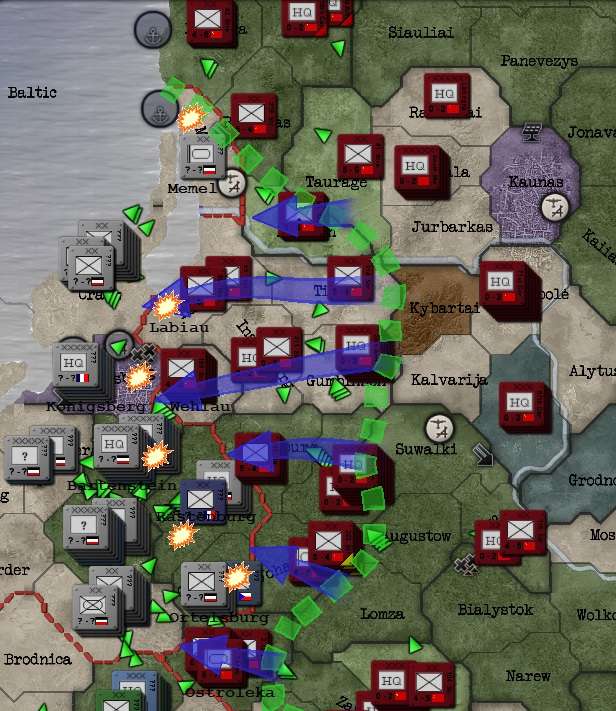

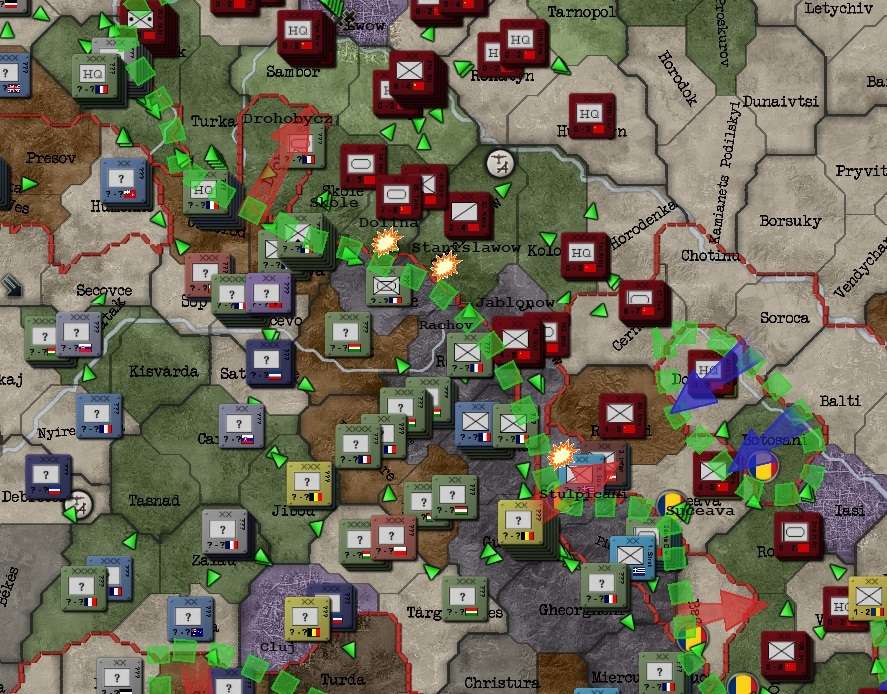
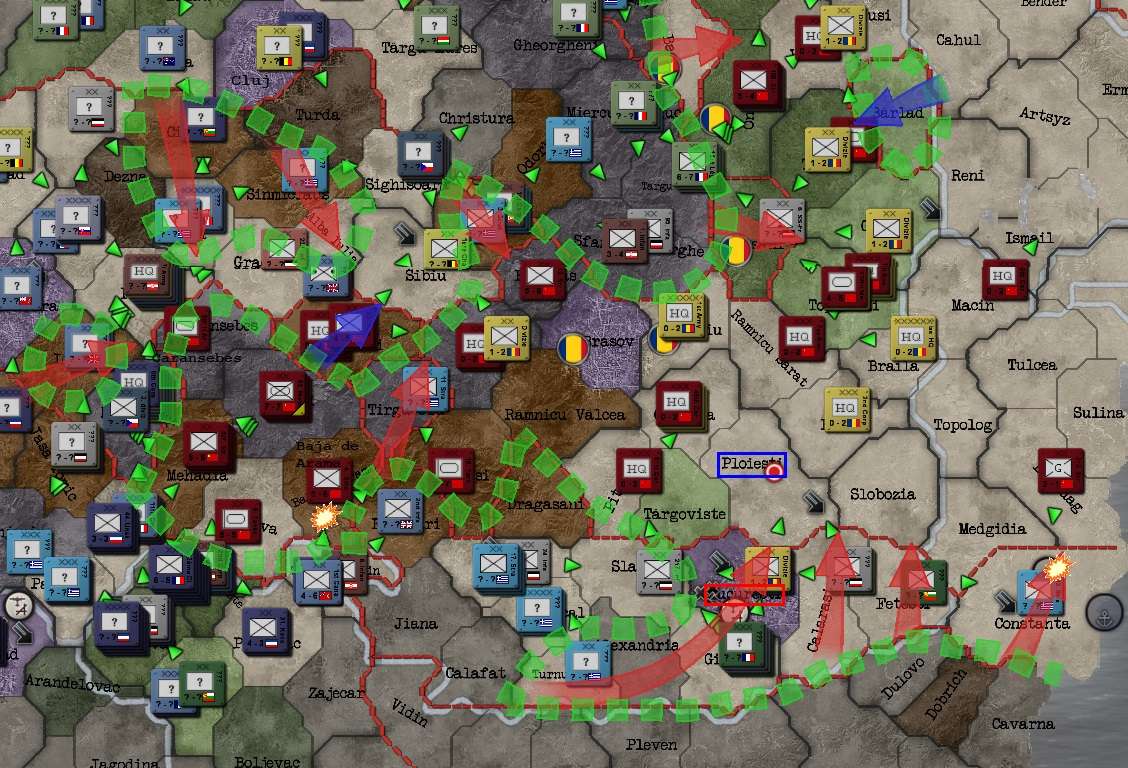
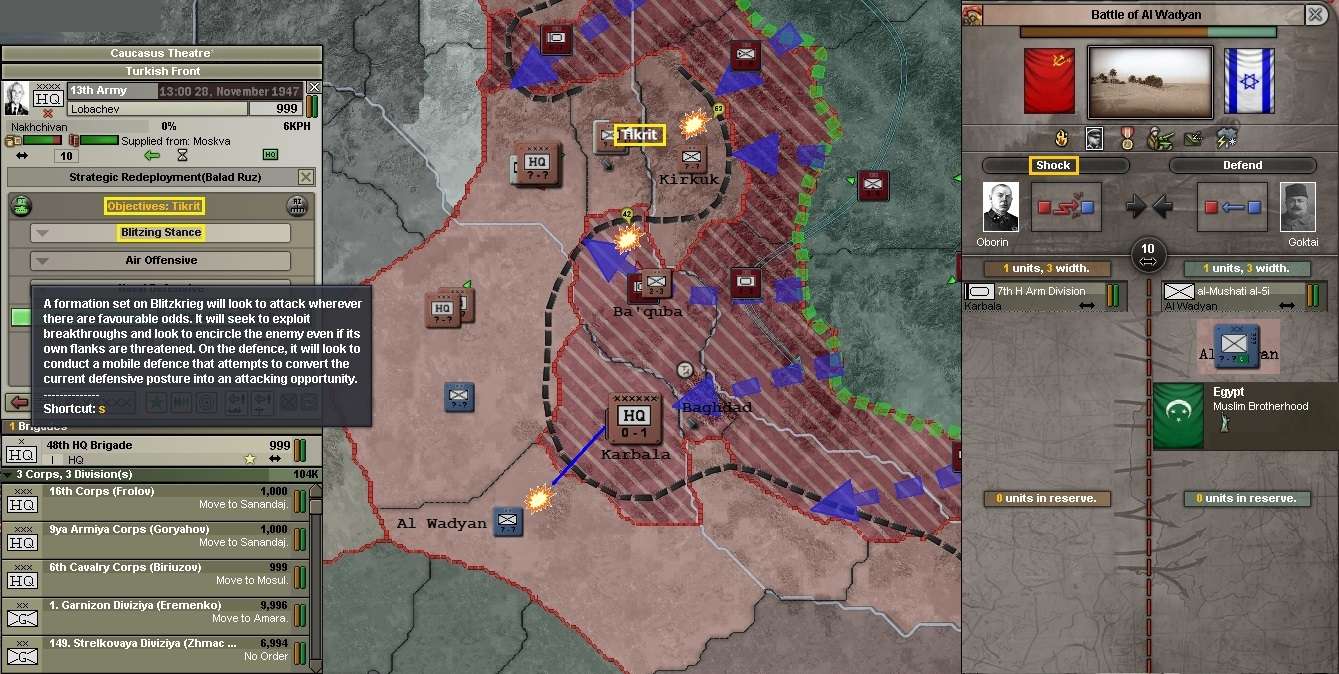

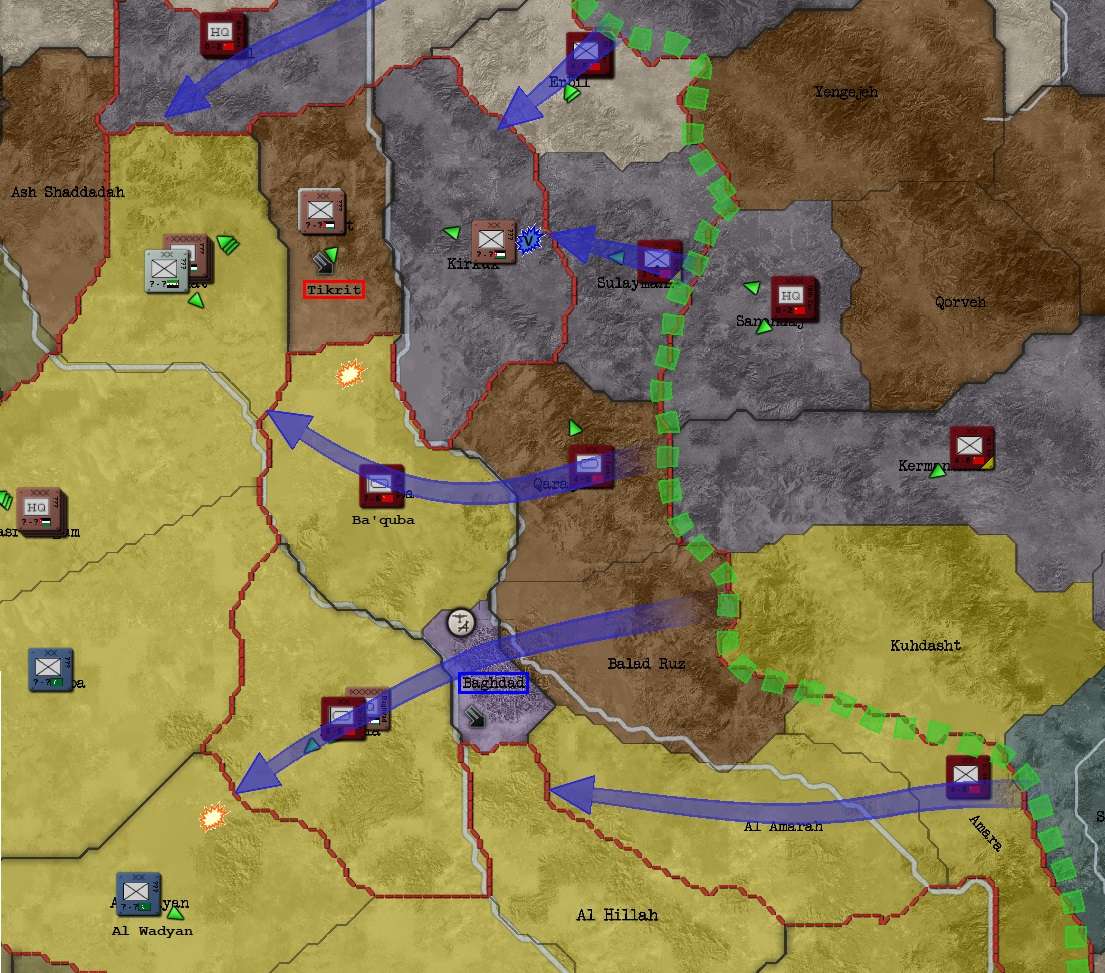
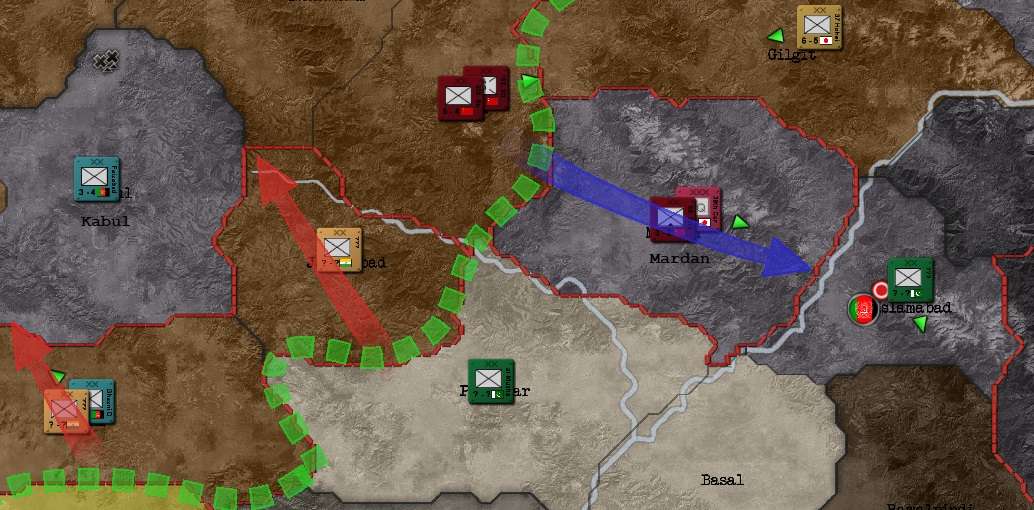
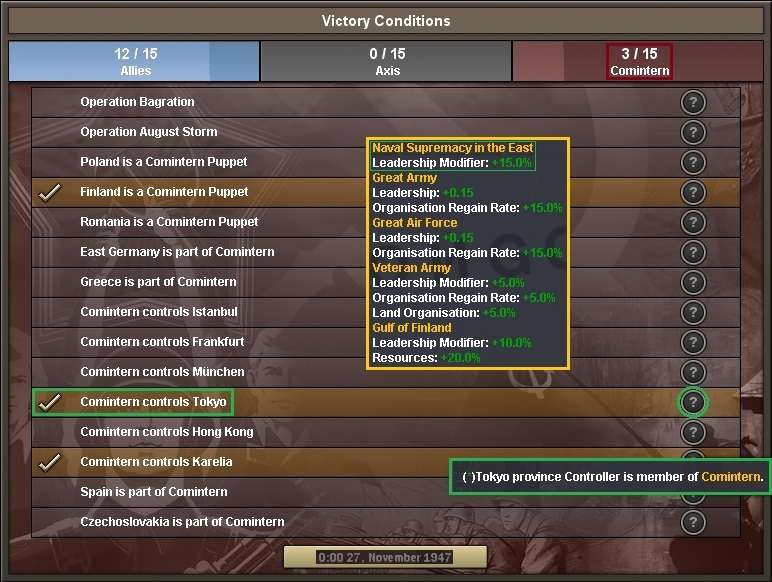
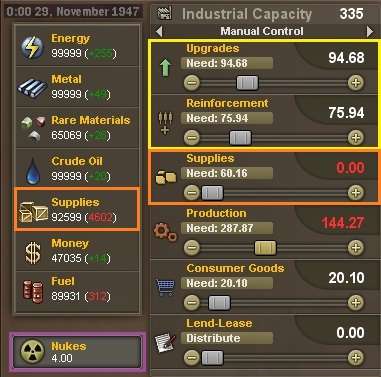
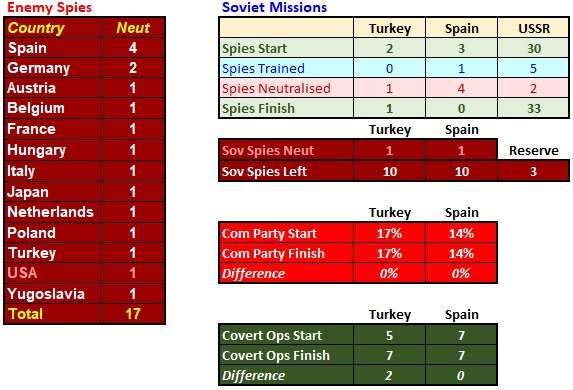
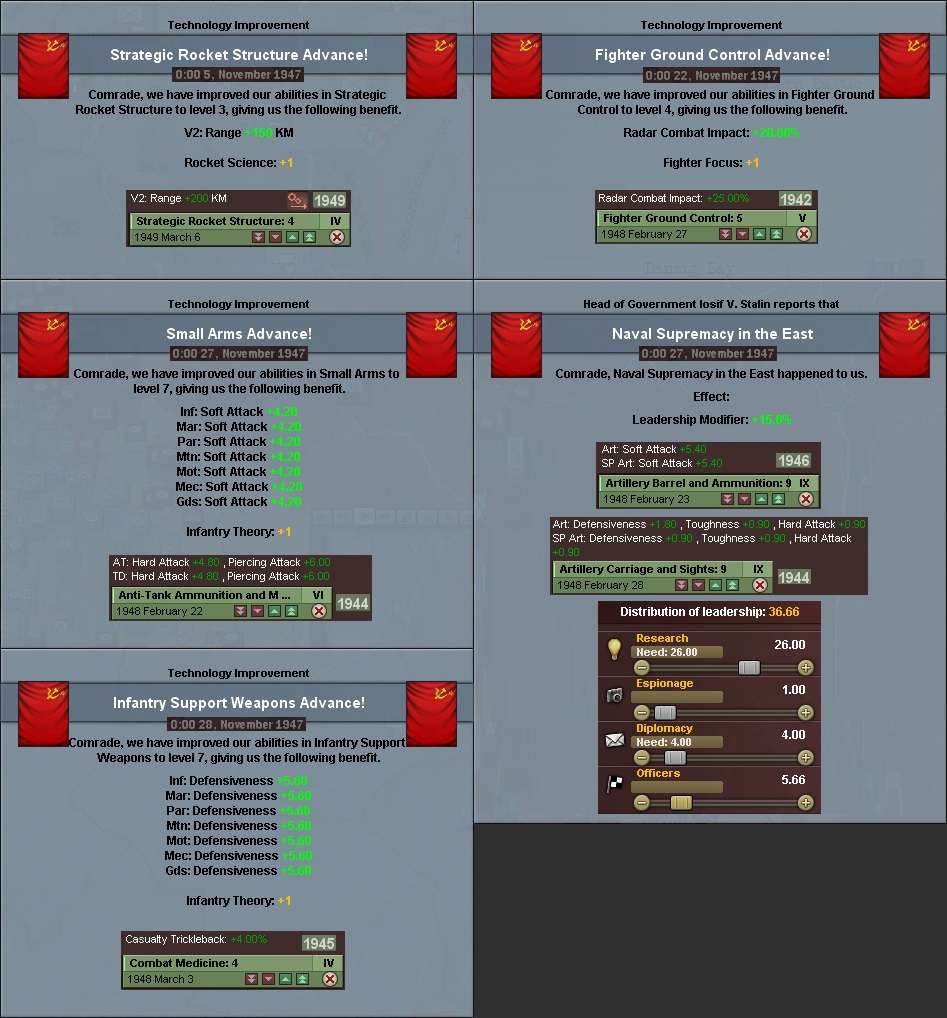

the NAVs trump the surface ships, the CAGs trump the NAVs, and we don't seem to have enough INT / MRs to trump the CAGs to close the loop but getting thereAnd the story still has a bit to play out, as the naval and CAG battle continues.
The Japanese CAG strikes (eight CAG wings flying from three CVs and three CVLs) hit again on the morning of 24 November, two groups flying separately but both finishing at 1000hr.The results were devastating, with all the previous accumulated damage compounded by the massed strikes and simultaneous naval combat. The last Soviet troops were also ashore by 1000hr, by which time the surface battle had concluded in an almost Tsushima-like defeat for the Soviet Navy as the few remaining Red Navy ships bolted for the now-occupied port of Toyohara to get away as quickly as they could.
This was specifically what I thought would go downThe answer was soon revealed: Stalin had wanted to demonstrate the Soviets could take a key Japanese city [ie a VP province] and no others had been within feasible early reach. With the developing stalemate in the West and knowing China could soon be sending troops to the Allied front, Stalin had to do something to change the calculus and quickly.
Such a Stalinian way to do thisWith Toyohara secure and the remnants of the fleet scurrying for port, it was time to show the Japanese the awesome power of Soviet technology. Ironically, the 3rd Strat Group was still recovering from its damaging attempt to strike Allied runways in northern Korea. But the TAC bombers groups (specifically their M/R escorts) in Vladivostok were just in range of Tokyo. And one specially modified bomber from 11th Tac Group [withdrawn from AI command for the mission] was soon flying into history.
It's a miracle they survived the blast of the nukes themselves, but in my headcanon it's the jet engines making the escape a fast dashThe cost this time was that the two Vladivostok-based TAC groups had to remain off line for repairs, having suffered badly during their long-distance desperate missions.
not good at all :/(Bucharest had by then fallen to the Allies – Romanian surrender progress at 95%)
Maybe - it will soon be revealed
Because winter campaigns starting in November always go well for the Soviets, this is clearly the right decision and nothing can possibly go wrong here.1 November 1947
With disposition adjustments completed and the A2A missile conversion process virtually complete, Stalin gave the coded order for movement to be in battle positions by 0200hr on 1 November 1947. Even though it would mean a winter campaign, his impatience would not let him wait any longer.
This is an important thing to get right, given the last time we tried this.The gauntlet was thrown down at 0200hr on 1 November 1947: the orders were preceded by the phrase “This is NOT an exercise! The Red Storm Rises!”.
I suspect this will be one of the less interesting segments of the reporting - a welcome change compared to certain other Comintern AARs, aye?After the first day of fighting, the Soviets were reporting a reinforcement requirement of 9,720 men (the reserve now sitting at 6,447,000).
Usually with these things, the initial battle takes the mot time and the following exploitation is more rapid. We shall see how this turns out.So ended the first day of WW3, with some success but not enough attacking in Poland for Stalin’s liking, though it was early days yet.
Chapter 38: Part One – 2 to 15 November 1947
Already our commitment to one-per-month reporting wavers. I do not see this improving with time, usually these kinds of AARs only become more detailed if they are not tightly controlled at the outset!With the first day of WW3 covered in detail, there will be more summarising from this point. But with the first few weeks crucial, very busy and setting the scene for future events, the reporting for the first month of the war will be divided into two halves. Subsequent reports should be able to revert to a one-per-month schedule. This report covers the first two weeks of the war, broken into theatres on a weekly basis.
The most important victory.Some of the border gore in Romania had been corrected
I believe so. One of the many Pdox efforts to nerf paras without fixing the underlying problem.NB: the transports have lost all organisation. I assume that is as a result of having performed a para drop.
This is terribly concerning. At least if we follow from Clausewitz, the defensive is the stronger form of warfare. Given the slow progress of the offensives it is a serious concern whether we have already reached our culminating point so soon, since even our biggest breakthrough is facing nothing but more stiff opposition. Hopefully Russian aerial success can turn the tide before it gets too much to turn back on the ground.So ended a tumultuous first two weeks of WW3 as the bold – or reckless – Soviet attempt to overthrow the Allied World Order had made modest be seemingly not decisive progress. Now the growing weight of reinforcing Allied forces were likely to be felt – and the enormous economic power of the US likely propping up the already strong main Allied economies.
Called it.I've decided to push through with the full month of November reporting before I turn back to my other AARs again, to keep the momentum going (there's a lot of info wrangling involved in this one). The next period of eight days was big, so it will take a whole chapter by itself.
It's too bad we can't develop stealth technology a few centuries out of date. Given all the other ahistorical nonsense in the late HoI3 techs it should be doable, but noooo...I've found a good use for them, I think, and am glad I've boosted the range on those V2s to be able to strike enemy air bases in depth. The attempts to do so with STRAT far less damage and got two of my three Strat groups cut up quite badly.
Also called this. We are now on the strategic defensive whether we like it or not, at least in the West. That is not good news.Another big battle came to a head at 1500hr on the 21st, with a big defensive win at Biala Podlaska – a Polish border province directly south-west of Brzesc Litewski taken earlier in the month – (Soviets 4,503/42,570; Allies 5,061/23,196 killed). But by that night, it was under attack yet again.
By 2200hr that night, the southern Polish salient was being slowly eroded and remained under pressure. The Soviet offensive in this sector had ground to a halt and was if anything being slowly pushed back.
Hooray!But this last effort was not enough for the British to hold on in Toyohara: they broke at 0600hr and an hour later, the Soviet marines and follow-up infantry divisions had secured their objective – at last! But there was no respite for the Soviet invasion fleet, which now had the retreated Soviet paratroopers aboard and were still trying to unload the last division and the Marine Corps HQ. The Japanese CAGs again struck in waves at 0900hr. By midday, the 5th DD flotilla had been sent to the bottom.
Oh no!The Japanese CAG strikes (eight CAG wings flying from three CVs and three CVLs) hit again on the morning of 24 November, two groups flying separately but both finishing at 1000hr.The results were devastating, with all the previous accumulated damage compounded by the massed strikes and simultaneous naval combat. The last Soviet troops were also ashore by 1000hr, by which time the surface battle had concluded in an almost Tsushima-like defeat for the Soviet Navy as the few remaining Red Navy ships bolted for the now-occupied port of Toyohara to get away as quickly as they could.
...hooray?NB: it seemed very harsh to do this while watching the Tokyo Olympics on TV, but that’s HOI3 for you.
History may not always be the same, but even in this ATL it rhymes with itself.t midnight, Japan formally surrendered. They would (forcibly) join the Comintern, but not as a combatant: they were in a truce with their former Allied partners.
Not to mention how crippled their government and economy probably are by the low NU which will restrict so many law choices and give them all kinds of horrible events. Possibly numerous coups may happen, although this is not Stalin's problem anymore.Comment: given their new NU of just 1% and the whole of Chinese-occupied China at Allied mercy, this was probably just as well.
With such high casualty rates we may yet have a chance at the very high strategic level, the Allies must not have as many men available as the Soviet Union can muster so we may eventually wear them down and be able to strike in a third phase of the war, with this failed offensive being the first phase and the grim defensive being the second.General Summary
Over the whole month, in all theatres the Soviets had lost more troops to ground combat than the Allies by nearly 9,000 men, but had caused almost double the air raid casualties. Of 291 land battles recorded, 155 had been won by the Soviets, 136 by the Allies – a trend that was turning in the Allies’ favour as the month ended. For both sides, well over half the casualties had come in the West. All up, over 464,000 troops had lost their lives so far in the first month of WW3.
It remained to be seen whether Soviet success in the East and their first use of atomic weapons could do anything significant to balance the stalemate in the West and the likely surrender of the Romanians.
Oh, come now, that would be blatantly unfair. The war would be over by Christmas then...Meh. Just nukes. Was hoping it would be you taking over from the AI
It is a well established phenomenon and one our author is somewhat prone to.Already our commitment to one-per-month reporting wavers. I do not see this improving with time, usually these kinds of AARs only become more detailed if they are not tightly controlled at the outset!
Poetry to do honour to a horribly bleak Stalinist ploy - how very suitable!The Sun has Risen
Let all bask in the nuclear light of Soviet progress
for the Dawn is ever the hope of the common man
Let the bourgeouis West skulk about in the night
The new Day is coming for them
In retrospect, I should have been building even more INT and MR over the last few years, but hindsight is a fine thing - that I wish I had in this case!the NAVs trump the surface ships, the CAGs trump the NAVs, and we don't seem to have enough INT / MRs to trump the CAGs to close the loop but getting there
Very much so - it was in character for this ATL, I think.This was specifically what I thought would go downlet's see how the hands will play now
Such a Stalinian way to do this
Yes indeed. And perhaps the Soviet nuclear development went down a different path, allowing a smaller bomb size. <waves magic dust over the whole thing as Soviet techs successfully attach nuclear warheads to their SS-6s>It's a miracle they survived the blast of the nukes themselves, but in my headcanon it's the jet engines making the escape a fast dash
Manchuria - I hope so. Poland: can't see a way through to that any time soon, the way things are going. And given Germany has twice the NU Japan had, it may take more than two nukes - if we can ever get a hold of any of their VPs.If we can knock Manchuria and Poland out of the war quick, then Germany can be taken out with 2 nukes and it would be France's turn to taste the sun of the revolution
Indeed, magic dust sprinkled again, given they also fit on my NAVs and V2s!Huh, so the TACs can indeed handle nukes... interesting.
Had the technology system been appropriate, it would have required a tech for miniaturization of nuclear weapons to permit tactical bombers to carry them... but that's just me and my defense-blog-reading ass.
Agreed. Similar calculus as the US considered in OTL 1945. And they had massive naval superiority and no other enemies left by then.Well, in game, Japan's Navy was proving a tough nut to crack. I can't think how much the Soviets would have paid in loses when they started invading the main islands. The use of atomic bombs was required. The Allied forces in Asia must have been surprised when the Japanese switched sides on them. Brazil joining the Allies is....annoying. But to be honest they don't bring much to the table. A few more infantry divisions. Some more resources. Of course, if the Allies share tech with them and give them free trade....win this war. Win this war faster. A million paper cuts can still defeat you. And if the minors exchange paper for chainsaws....
Haha. Much as I was tempted, the micro-managing option was refused for standard land ops. Still, not many HOI3 AARs I've seen of late that feature mass nuclear strikes, so there's a little novelty there.Meh. Just nukes. Was hoping it would be you taking over from the AI
Ye-esss ... could be another example here!Because winter campaigns starting in November always go well for the Soviets, this is clearly the right decision and nothing can possibly go wrong here.
Quite so.This is an important thing to get right, given the last time we tried this.
Oh indeed. If we run out of MP here, then the world will be in its hand-basket and already in Hell!I suspect this will be one of the less interesting segments of the reporting - a welcome change compared to certain other Comintern AARs, aye?
We will indeed.Usually with these things, the initial battle takes the mot time and the following exploitation is more rapid. We shall see how this turns out.
Yes, guilty this time, pleading extenuating circumstances. First month, scene setting for the long haul, and a big story to cover in Toyohara, so I did stretch it out. I really do plan to reel it back in though in subsequent outings. I'd stuck to it until now and plan to get back on track.Already our commitment to one-per-month reporting wavers. I do not see this improving with time, usually these kinds of AARs only become more detailed if they are not tightly controlled at the outset!
Yes the War v Gore (border, not Al).The most important victory.
Ah well, I suppose it kinda works.I believe so. One of the many Pdox efforts to nerf paras without fixing the underlying problem.
It is a concern, and one that grew during the rest of the month. The VVS was keeping us in it, but it transpired I needed more of them to turn it from superiority and denial into air supremacy.This is terribly concerning. At least if we follow from Clausewitz, the defensive is the stronger form of warfare. Given the slow progress of the offensives it is a serious concern whether we have already reached our culminating point so soon, since even our biggest breakthrough is facing nothing but more stiff opposition. Hopefully Russian aerial success can turn the tide before it gets too much to turn back on the ground.
Yes, I think about it often, but was so used to enemy on a battle map marked in red and friendlies blue that I just can't change it.As an aside, the fact that the Soviets are blue and the Allies red in the casualty charts is confusing.
Fair cop, but one can have goals and principles without being too inflexibly bound to them.Called it.
A nice thought (!?). But I would have settled for fair peace treaties against Manchuria and Japan at the end of WW2 and an AI willing to attack properly when ordered to!It's too bad we can't develop stealth technology a few centuries out of date. Given all the other ahistorical nonsense in the late HoI3 techs it should be doable, but noooo...
Yes, it was my fear from the start. Still, we ain't done with yet.Also called this. We are now on the strategic defensive whether we like it or not, at least in the West. That is not good news.
Nothing comes without a cost, it seems. A large part of the Navy and three nukes to extract Japan from the war? Probably worth it, considering how antiquated the navy was.Hooray!
Oh no!
...hooray?
True.History may not always be the same, but even in this ATL it rhymes with itself.
Yes, I don't think I'll be getting much out of them, other than their absence from the ranks of the enemy. I really needed them to start on my side in this one, plus Manchuria, which would have allowed me to send far more back to help in the west.Not to mention how crippled their government and economy probably are by the low NU which will restrict so many law choices and give them all kinds of horrible events. Possibly numerous coups may happen, although this is not Stalin's problem anymore.
It may come to that, but the Allies really do have a lot of stuff reinforcing them all the time. The VVS, nukes and maybe German supply problems may be the only thing keeping us in it for now.With such high casualty rates we may yet have a chance at the very high strategic level, the Allies must not have as many men available as the Soviet Union can muster so we may eventually wear them down and be able to strike in a third phase of the war, with this failed offensive being the first phase and the grim defensive being the second.
The broad superiority of the VVS is also a big bright spot and certainly one to be played up in the next monthly issue of Pravda.
This one is shaping up like an Olympic high-jump, with the bar set very high. As someone described it on TV here recently, its like trying to jump well over the top of your front door, without touching it!Oh, come now, that would be blatantly unfair. The war would be over by Christmas then...
Per above, I beg the indulgence of my dear readAARs and will try to dig myself back out again soon!It is a well established phenomenon and one our author is somewhat prone to.
I suspect this is true, and was not really optimistic given how the generals didn't attack en masse in the abortive first 'exercise', either, even with revised dispositions, orders and objectives.It is mildly concerning that despite the Germans being entirely out of fuel and supply the Western theatre is still bogging down, this is as good as it is going to get from a Soviet perspective and it is not going well. Fundamentally I have confidence the AI will cock things up somehow (particularly if games of TAG are being played), if nothing else the ongoing progress through Iraq will probably utterly confuse the British AI to deploy it's entire army to Cyprus or something similar, but it may well be a grinding fight until then.
But I need to take VPs first and may well run out of nukes knocking them out, even if I can take them.10% NU per NUke, that is problematic for the western allies.
They did. One more nuke than the US required in OTL.Well, the Pacific Fleet did their duty, dying so a VP could be captured! The nuclear annihilation of Japan was quite something, I suspect Godzilla will be on steroids in this universe.
Yeah, not expecting anything out of them now, but it was indeed best they remained in truce as the Chinese portion would have been quickly overrun. I won't mod the unity, on gebneral 'making this as hard as I can' principles!It's a bit disappointing that Japanese unity never comes back after being bombed. It's fortunate they didn't join the war because they literally would have surrendered immediately and gained you nothing. I would be ok if you modded their unity to be slightly higher (assuming they ever join the war).
True. But given I can't use them against troops, the prospects are not immediately encouraging.I have to agree with NuclearSlurpee that the slow pace of advance in the west is concerning. The way to victory will likely be paved with nuclear bombs...
You cannot say this to El Pip, who firmly believes that the British are the only power that ever did anything worth writing about anyways.I could confuse the British AI, perhaps, but it is really France, Germany and the other Western European Allies (basically all of Europe) that I need to trip up, and it's not happening yet. Will see if anything gives as we grind on.
